North American Meat Processors Associations Names for Cuts of Beef Chart
2021 Center of the Plate Training held at Texas A&M University
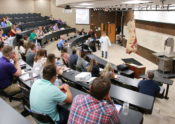
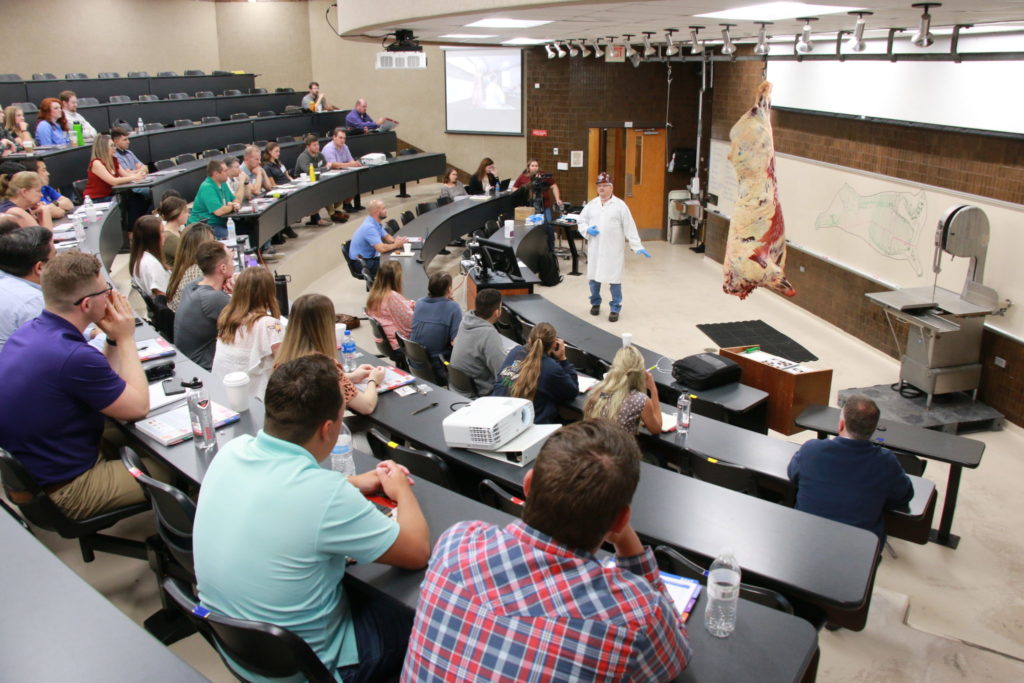
NAMI Eye of the Plate Grooming
The 2021 Eye of the Plate Training, sponsored by the North American Meat Institute, was held at the Rosenthal Meat Center at Texas A&K University on July xx-22, 2021. The Eye of the Plate Training is designed for purchasers and sellers of meat and poultry to ameliorate sympathize the nomenclature and utilization of cuts for the foodservice and retail sectors. Ann Wells, Director, Education and Workforce Development, North American Meat Found, is the coordinator of the plan, and Davey Griffin, professor and Extension meat specialist, Department of Animal Science, Texas A&Thou Academy, provided on-campus leadership and served every bit the principal cut instructor for the beef, veal, lamb, and pork portions of the plan. Jeff Savell, distinguished professor of animal science, Chris Kerth, associate professor of brute scientific discipline, and Kerri Gehring, professor, also helped with commitment of the programme.

Davey Griffin talking near beefiness carcass anatomy

Davey Griffin talking about beef carcasses
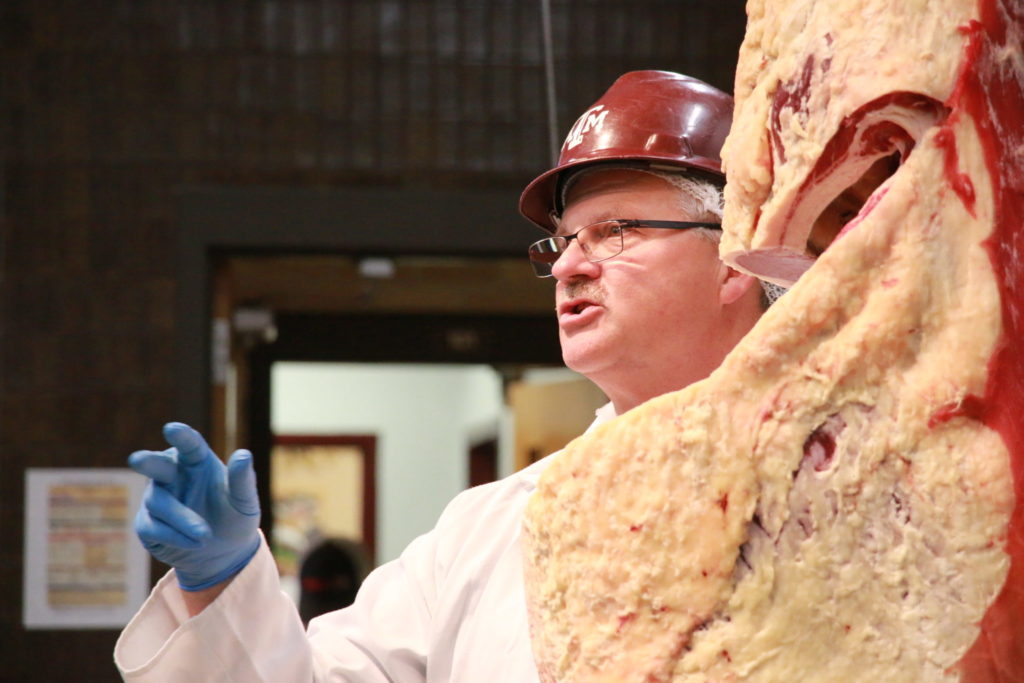
Davey Griffin discussing beefiness grading
The North American Meat Found conducts the Center of the Plate Training in conjunction with the Foundation for Meat & Poultry Inquiry & Education, American Clan of Meat Processors, American Meat Science Clan, Chicago Midwest Meat Association, Southwest Meat Association, Southeastern Meat Association, and Canadian Meat Council. Sponsors included the Beef Checkoff, the Pork Checkoff, the Lamb Checkoff, and Merck Animal Wellness. Representatives from the American Lamb Board, and the National Pork Board participated in the program.
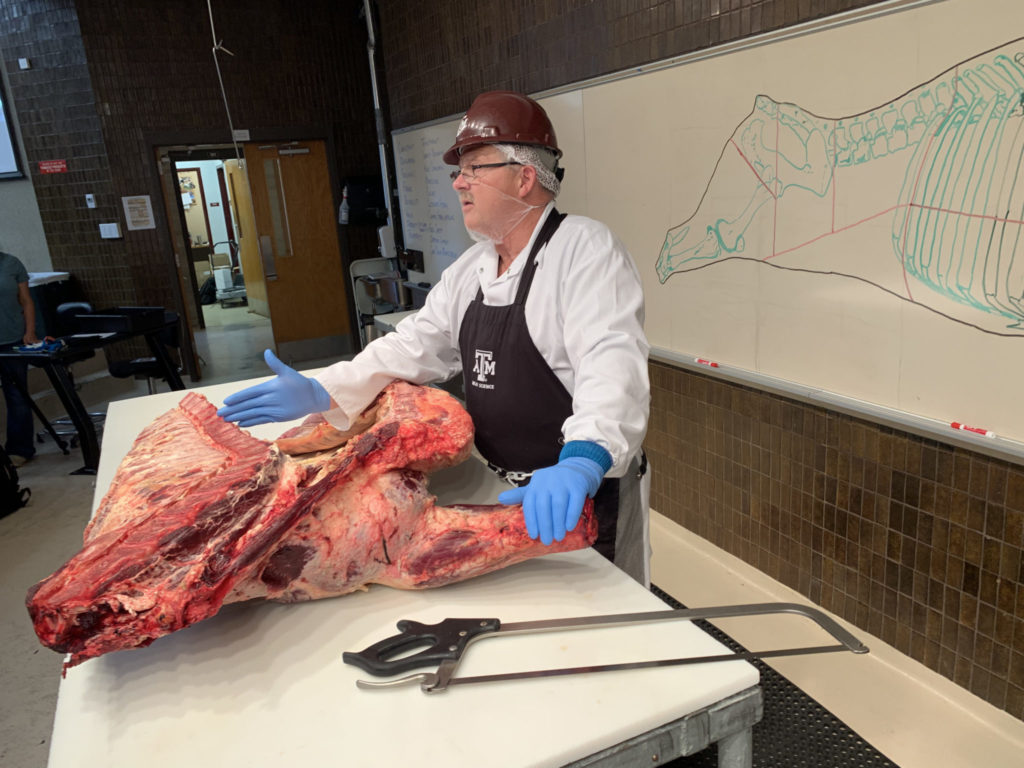
Davey Griffin describing where the rib/plate is separated from the chuck/brisket/foreshank
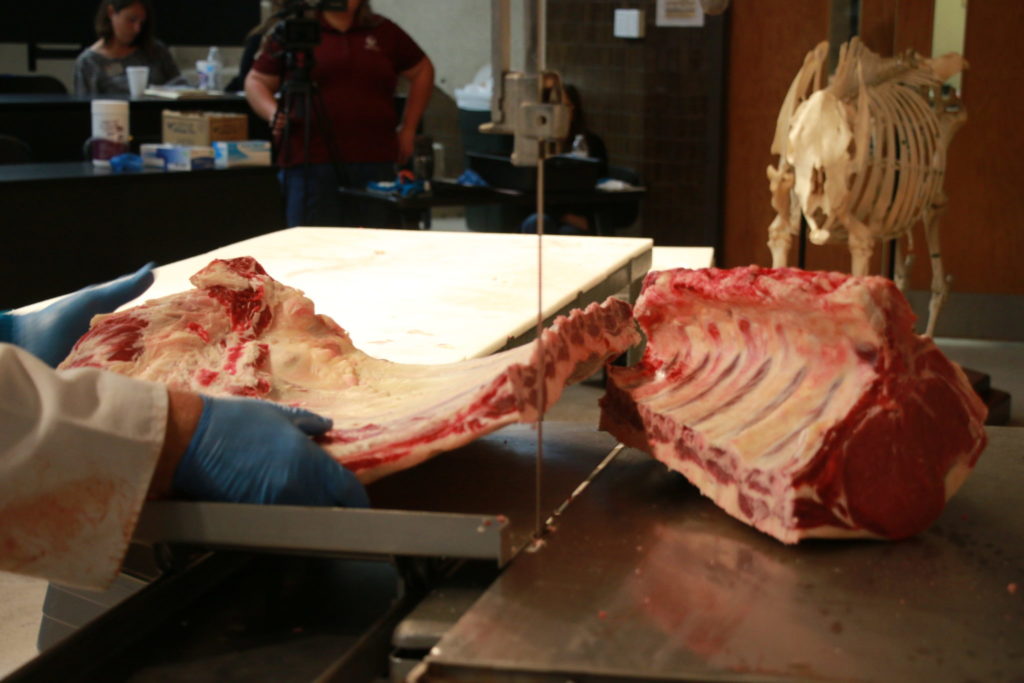
Separating the rib from the plate

Davey Griffin chining a beefiness rib

Davey Griffin discussing bovine anatomy
The Center of the Plate Training is conducted in a classroom surround. Over l participants interacted with the instructors who performed cutting demonstrations showing where the cuts came from and the numbering and nomenclature system used to depict them. The Institutional Meat Purchase Specifications (IMPS), maintained and published by the United States Section of Agriculture, are the basis for all product identification. The N American Meat Institute publishes the Meat Buyer's Guide, which provides a pictorial clarification of the IMPS and is the workbook used throughout the grooming program.
Donna Moenning, Senior Account Manager, LOOK East, gave a presentation that included several videos on production practices of veal before Davey Griffin demonstrated unlike cutting styles for veal.

Davey Griffin cutting veal products
Mary Humann, American Lamb Board, gave an overview of the market for lamb before Davey Griffin showed various cuts and styles of lamb.
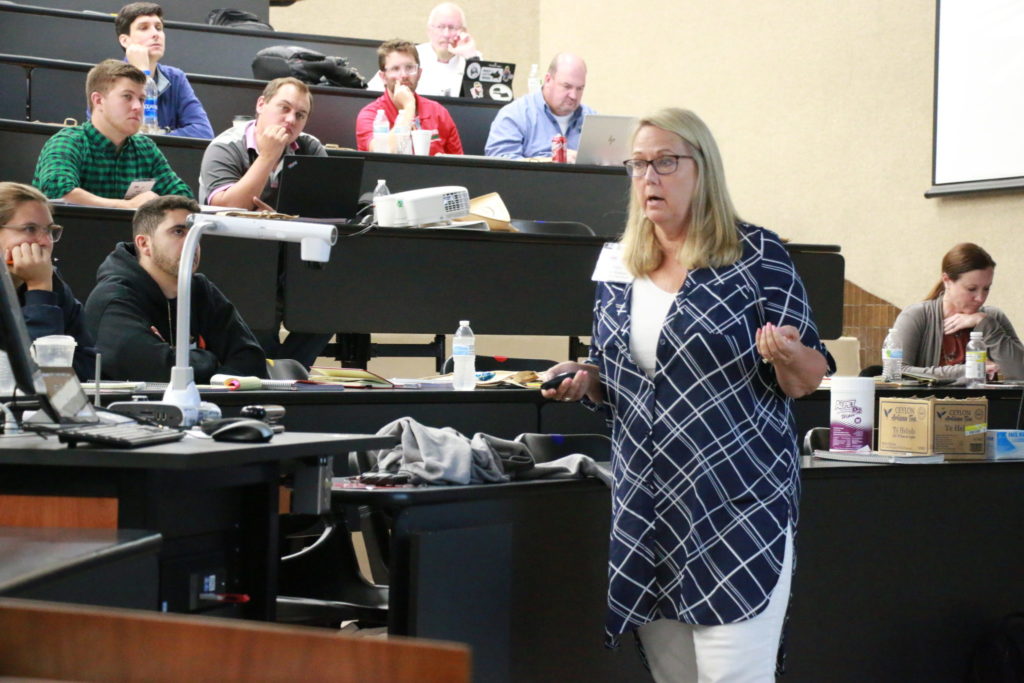
Mary Humann, American Lamb Council
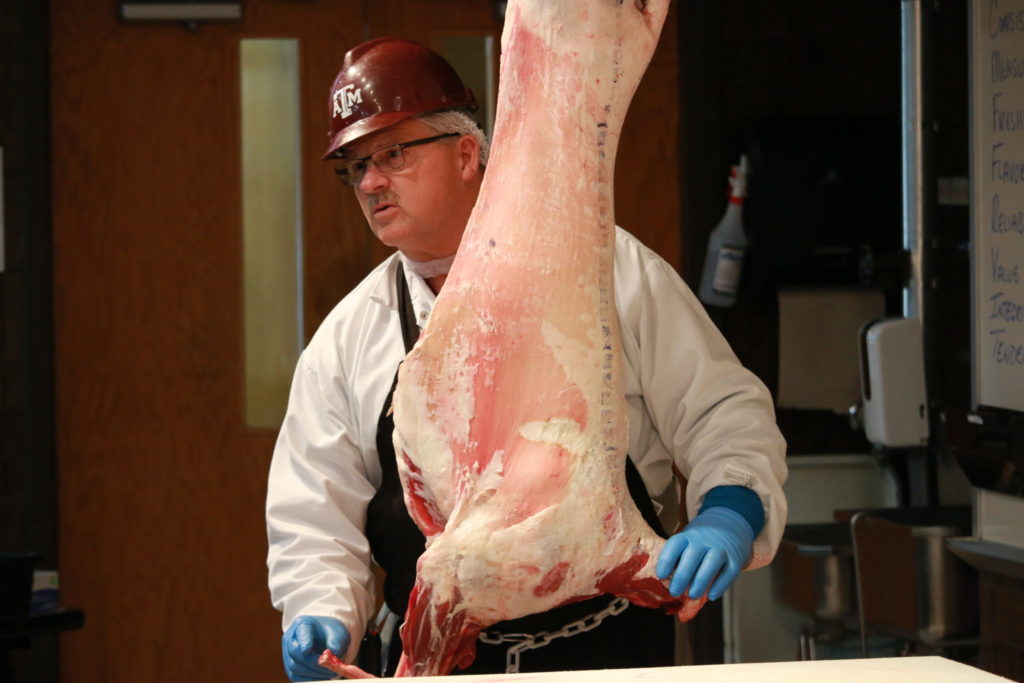
Davey Griffin discussing lamb carcass cut
The pork portion of the training was conducted by Jimmy Murray and Clay Eastwood of the National Pork Board with assistance from Davey Griffin.
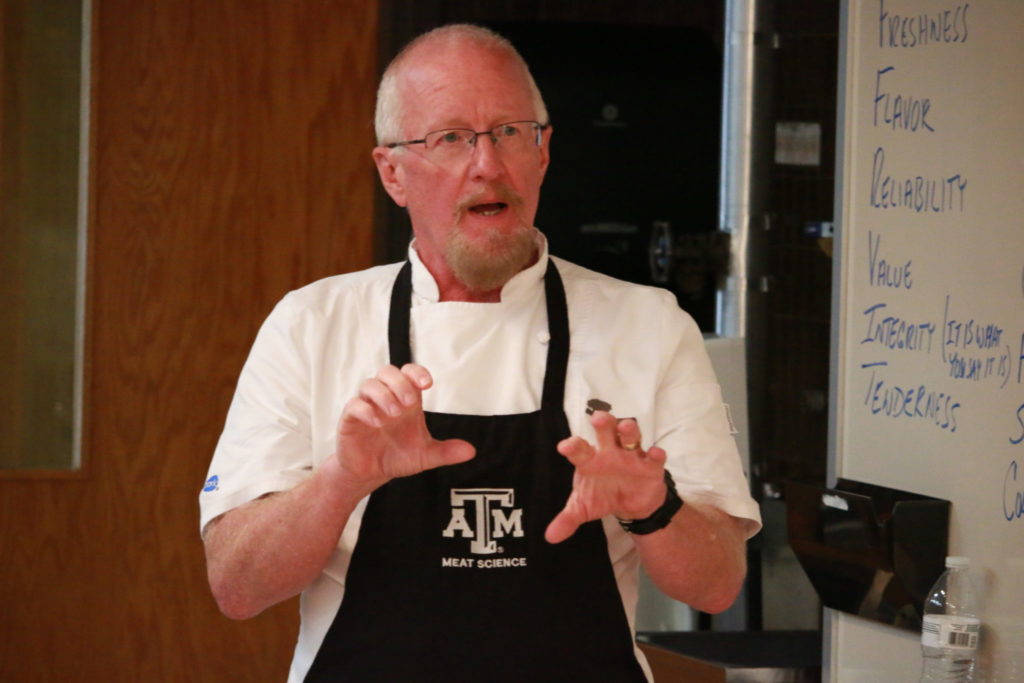
Jim Murray, National Pork Board
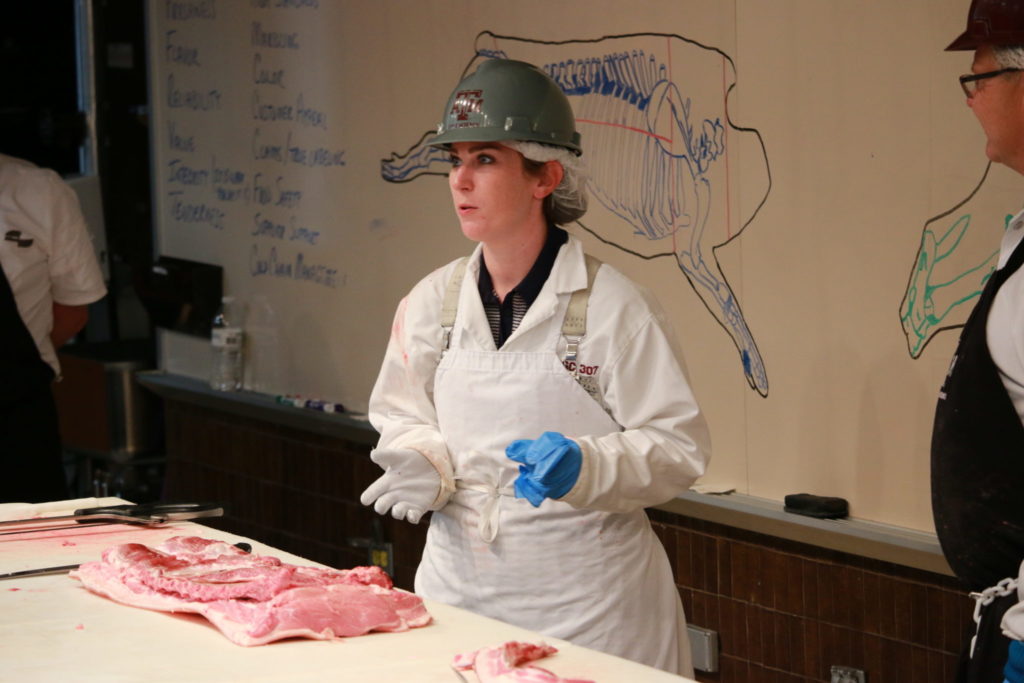
Dirt Eastwood, National Pork Board
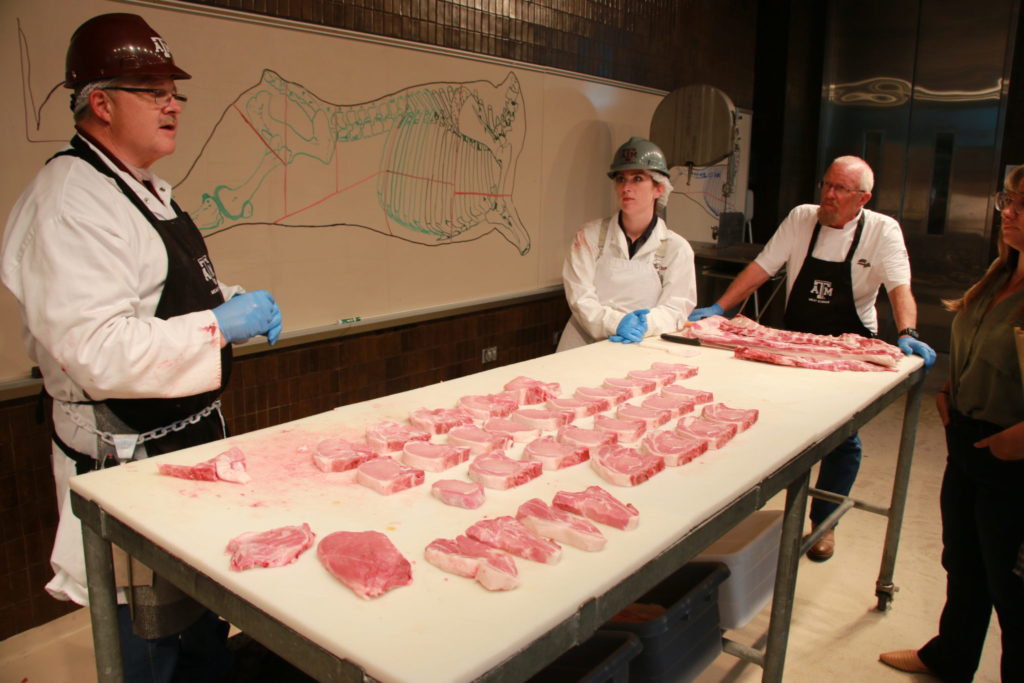
Davey Griffin, Dirt Eastwood, and Jim Murray describing cuts of pork
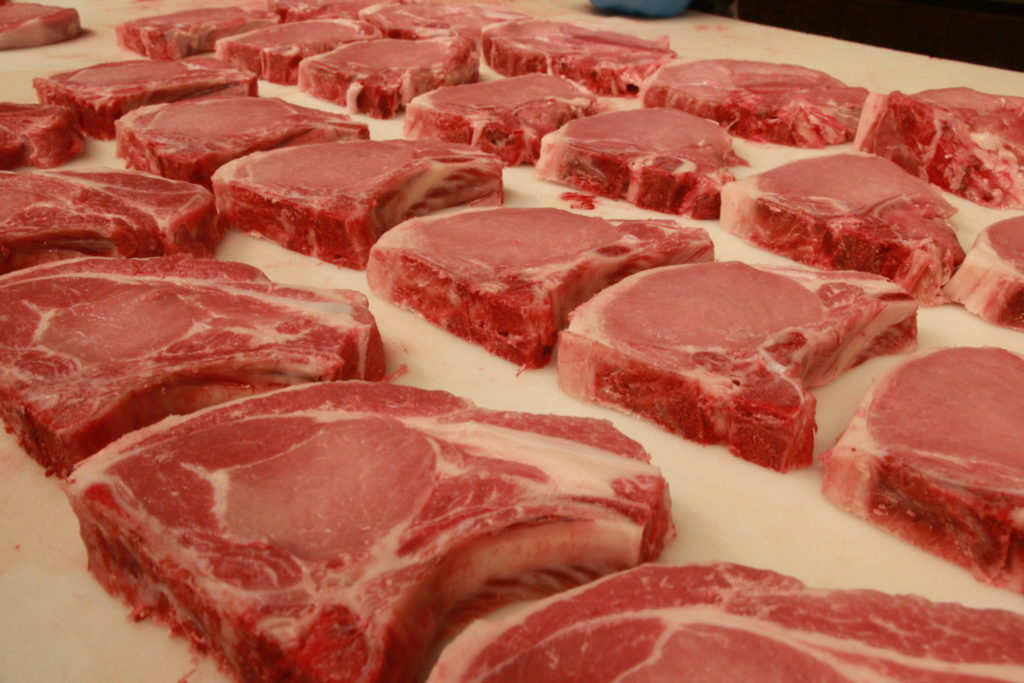
Cuts of pork
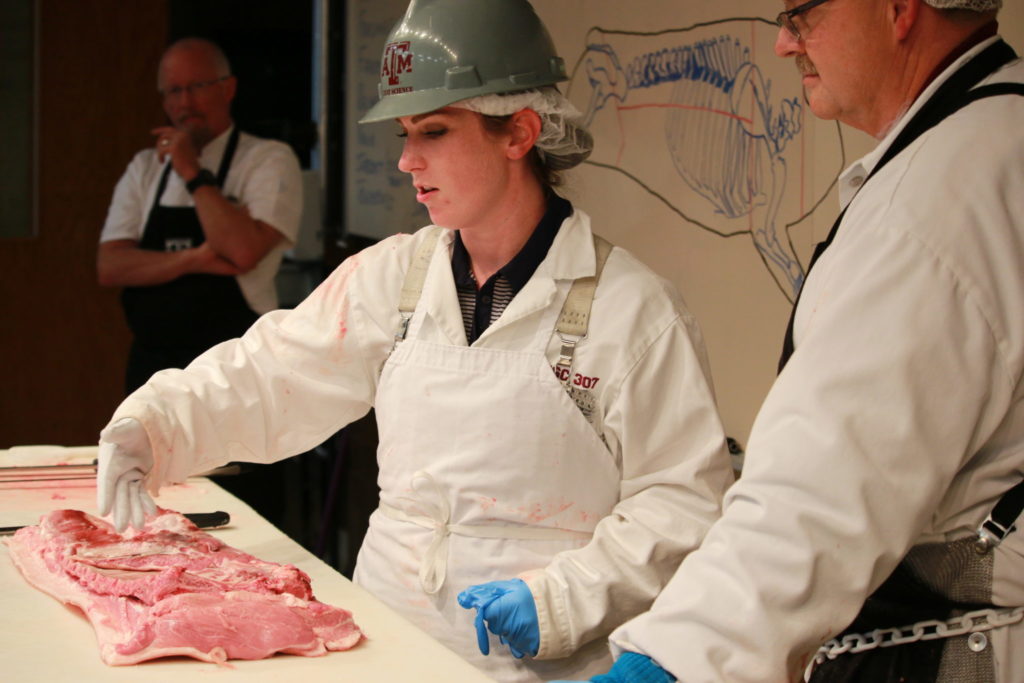
Dirt Eastwood, National Pork Lath

Davey Griffin talking about pork loin fabrication at the Centre of the Plate Workshop
A discussion of processed meats led by Chris Kerth. Kerth gave a presentation on processed meat ingredients and labeling, and he showed a variety of locally available processed meat products and the labels and marketing claims fabricated for each.

Chris Kerth, Associate Professor
Kerri Gehring gave a presentation on Meat Nutrition every bit a part of The North American Meat Institute'due south commitment to the Poly peptide PACT.

Kerri Gehring, Professor and Presidential Impact Fellow

Kerri Gehring, Professor and Presidential Touch on Beau
The poultry portion of the preparation was conducted by members of the Agricultural Marketing Service of the Us Department of Agronomics. Chad Brillhart and Gerald Laird led the discussion on poultry grading, terminology, and common uses of specific poultry products.
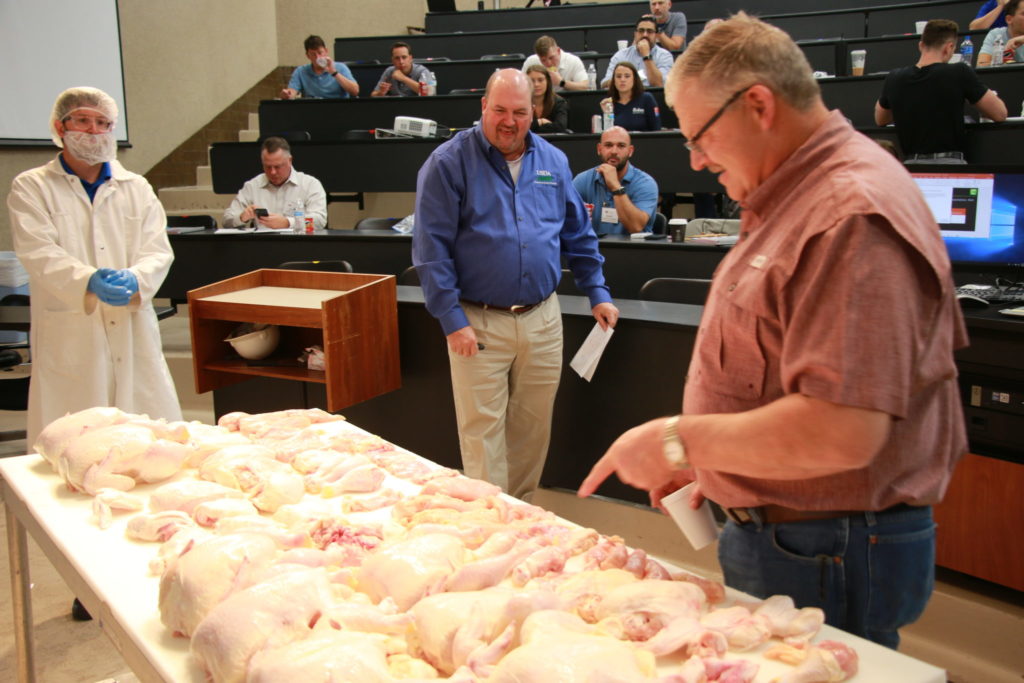
Poultry at the Center of the Plate Workshop
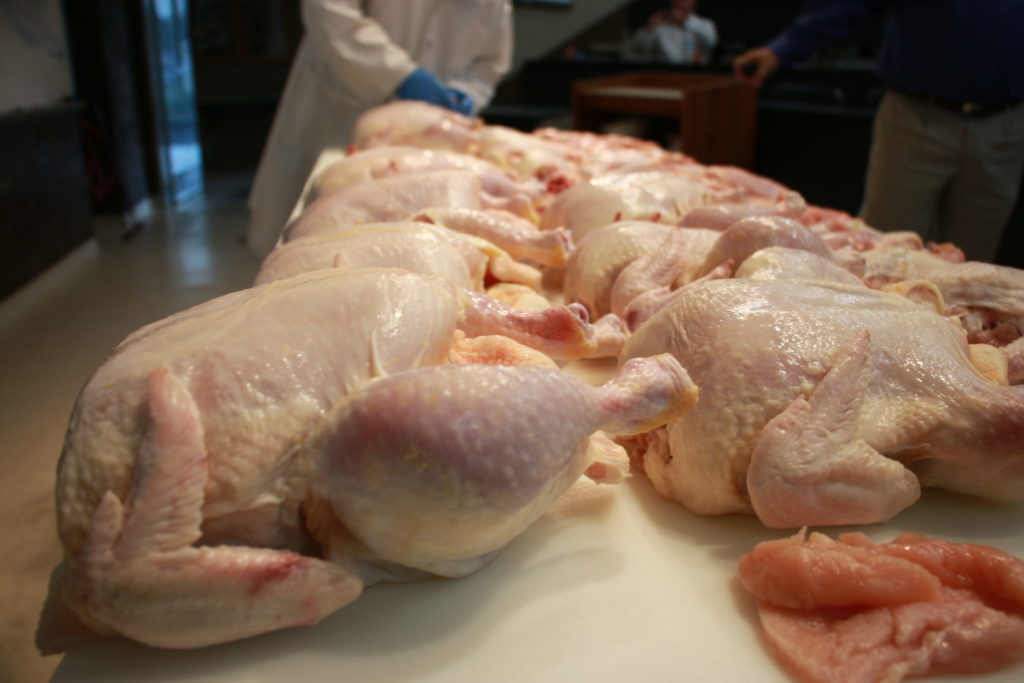
Poultry at the Centre of the Plate Workshop
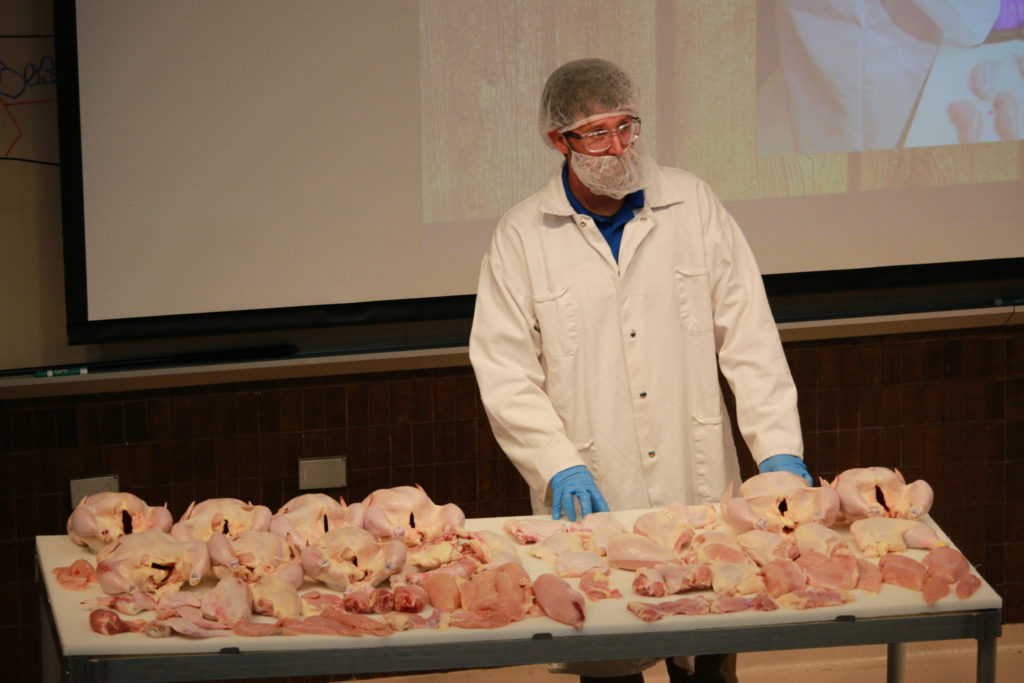
Chad Brillhart, Banana to the National Poultry Supervisor
Texas A&M University has hosted the Heart of the Plate Training since 2005, and nosotros appreciate the opportunity to work with the Northward American Meat Found on this program each yr.
Oct, the start of dark cut beefiness flavor

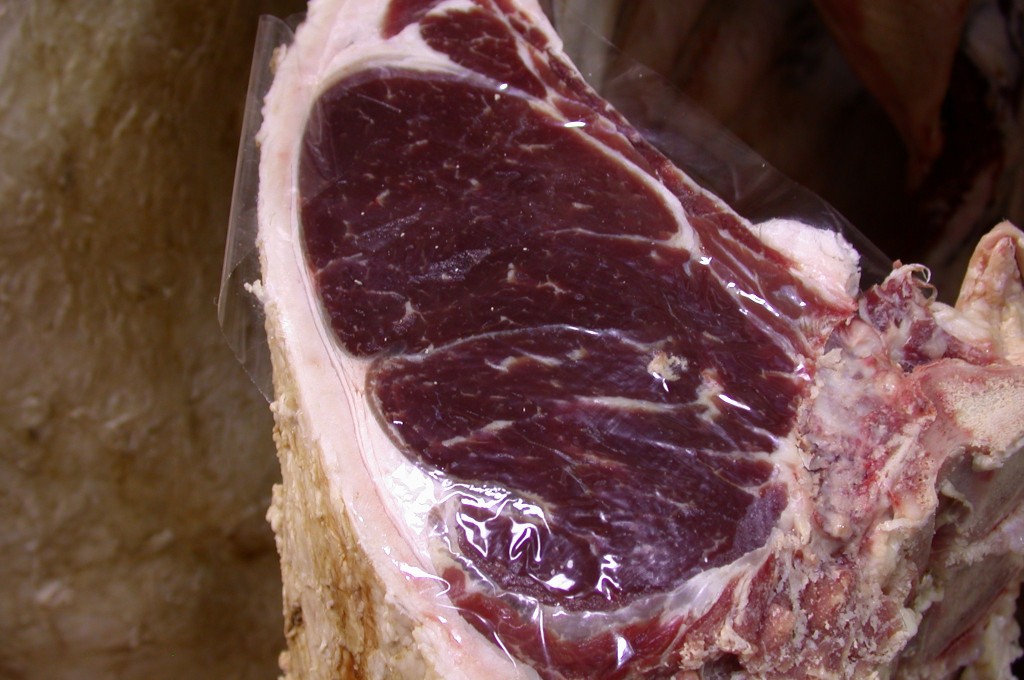
Beef ribeye from nighttime cutting beef carcass
With the inflow of October each yr, at least in N America, the incidence rate for dark cutting beef begins to increment. Dark cutting beef is the result of long-term stress where cattle deplete glycogen stores in the muscle before slaughter resulting in less lactic acid being produced in the post-mortem muscle that would normally produce the vivid red-red beef color in the lean. As the proper name implies, the lean is darker in color because information technology has a higher pH than normal beef. While there are many factors that tin can lead to long-term stress in cattle throughout the year, the inflow of the beginning major cold fronts where temperatures drop dramatically is a certain sign that the incidence rate volition begin to ascension at least for a time until the weather begins to become more consistent with fewer broad temperature swings.
The best evidence of this seasonality was reported by Boykin et al. (2017) in the National Beefiness Quality Audit – 2016. Instrument grading information was obtained from beef packers throughout the year to wait at a variety of carcass characteristics, including the incidence of night cutters. The chart below represents the findings of the month-to-month variation in nighttime cutting incidence.

Dark cut incidence, by calendar month, 2016
While there is nothing that can exist done about the weather, working to minimize other sources of long-term stress through proper treatment, ship, and holding at the packing establish may exist helpful during this time. Current international inquiry is focusing on factors such as grass- versus grain-feeding, muscle fiber types, and other atmospheric condition that may increase the risk of the occurrence of dark cutting beef.
By the way, the reference to North America above is that in the Southern Hemisphere, the contrary occurs with more dark cutting occurring as autumn arrives in March and April.
Source:
Boykin, C. A., 50. C. Eastwood, 1000. M. Harris, D. South. Hale, C. R. Kerth, D. B. Griffin, A. N. Arnold, J. D. Hasty, K. E. Belk, D. R. Woerner, R. J. Delmore, Jr., J. North. Martin, D. L. VanOverbeke, G. M. Mafi, M. M. Pfeiffer, T. Eastward. Lawrence, T. J. McEvers, T. B. Schmidt, R. J. Maddock, D. D. Johnson, C. C. Carr, J. 1000. Scheffler, T. D. Pringle, A. M. Stelzleni, J. Gottlieb, and J. W. Savell. 2017. National Beefiness Quality Audit-2016: Survey of carcass characteristics through instrument grading assessments. J. Anim. Sci. 95:3003-3011. doi:10.2527/jas2017.1544. [Journal of Animal Science link] [PubMed link]
2020 Introductory HACCP Courses and Beyond Basics Workshops appear

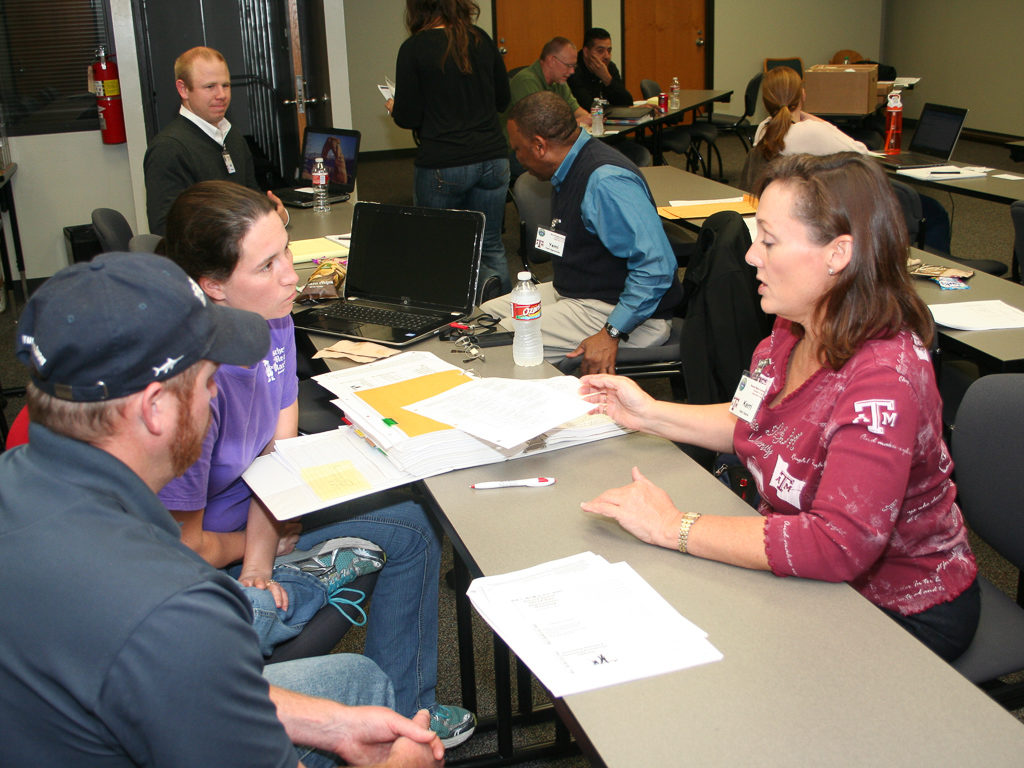
Kerri Gehring helping participants at Beyond Basics HACCP Plan Improvement Workshop
The 2020 dates for Introductory HACCP Course and Beyond Basics: HACCP Program Improvement Workshop have been set. All courses are taught in the Kleberg Center on the campus of Texas A&M University in Higher Station, Texas by Kerri Gehring and Jeff Savell from the Department of Animal Science.
Introductory HACCP Form
- May 5-6, 2020
- December ane-two, 2020
Registration: Introductory HACCP Form
Beyond Basics: HACCP Program Improvement Workshop
- May 7-8, 2020
- November 5-vi, 2020
Registration: Beyond Basics Workshop
For more information, contact Tiffany Walsingham at 979-862-3643 or twalsingham@tamu.edu.
2019 Center of the Plate Training held at Texas A&G Academy
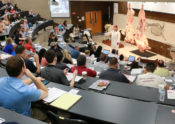
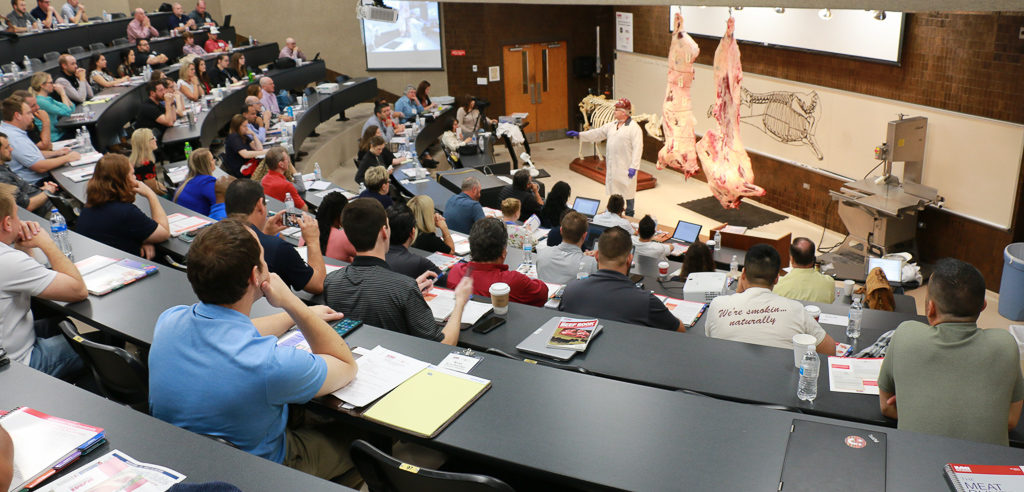
Davey Griffin at the NAMI Heart of the Plate Training
The 2019 Center of the Plate Preparation, sponsored by the N American Meat Constitute, was held at the Rosenthal Meat Heart at Texas A&M University on June 18-20, 2019. The Eye of the Plate Grooming is designed for purchasers and sellers of meat and poultry to meliorate understand the classification and utilization of cuts for the foodservice and retail sectors. Ann Wells, Managing director, Education and Workforce Development, North American Meat Institute, is the coordinator of the programme, and Davey Griffin, professor and Extension meat specialist, Section of Animal Science, Texas A&Yard Academy, provided on-campus leadership and served every bit the primary cutting teacher for the beefiness, veal, lamb, and pork portions of the program. Jeff Savell, distinguished professor of animal science, and Chris Kerth, associate professor of animal science, also helped with delivery of the program.

Davey Griffin reading from the Meat Buyer'southward Guide
The Northward American Meat Constitute conducts the Middle of the Plate Training in conjunction with the American Association of Meat Processors, American Meat Scientific discipline Clan, Chicago Midwest Meat Association, Southwest Meat Clan, Southeastern Meat Clan, and Canadian Meat Council. Sponsors included the Beefiness Checkoff, the Pork Checkoff, the Lamb Checkoff, and Merck Animal Health. Representatives from the American Lamb Board, and the National Pork Lath participated in the plan.
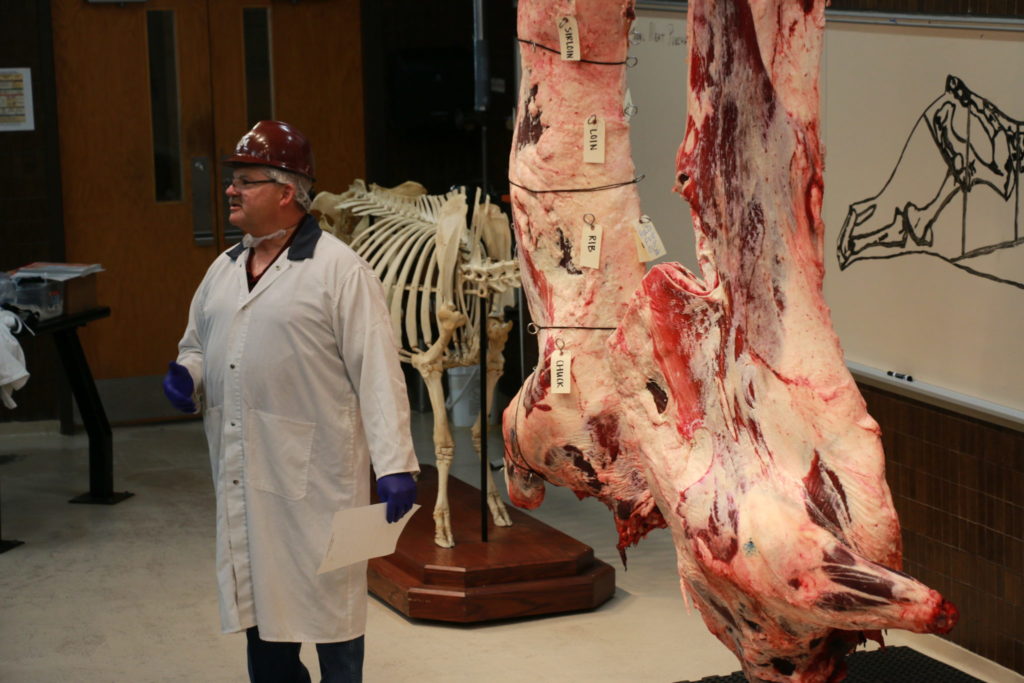
Davey Griffin talking nearly anatomy
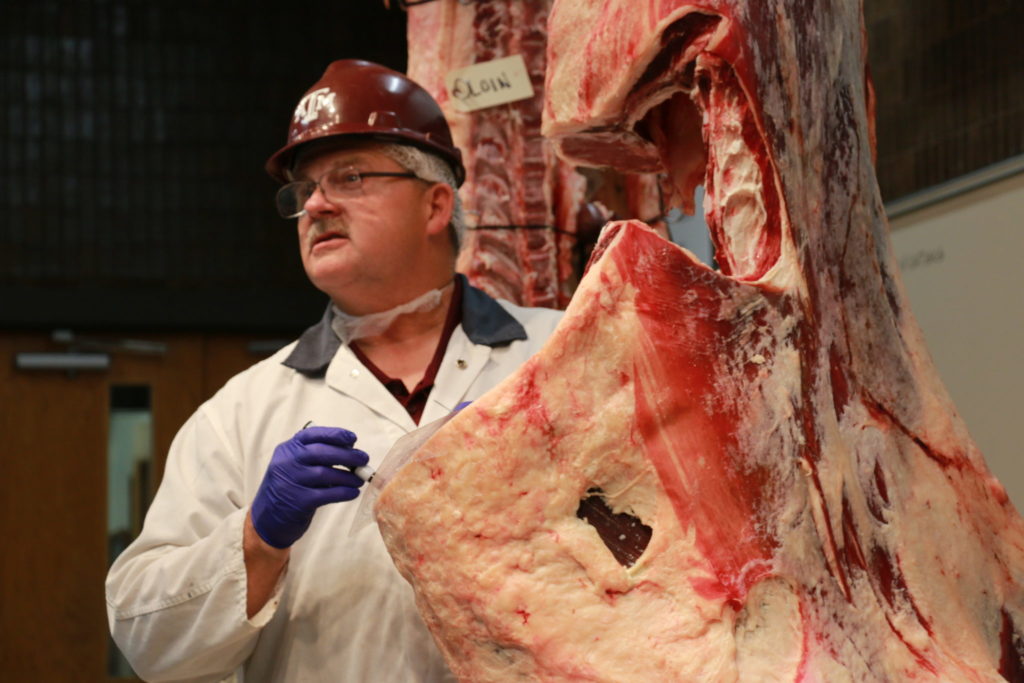
Davey Griffin talking about beef grading
The Centre of the Plate Training is conducted in a classroom environment. Over 90 participants interacted with the instructors who performed cutting demonstrations showing where the cuts came from and the numbering and nomenclature system used to describe them. The Institutional Meat Buy Specifications (IMPS), maintained and published by the United states Department of Agronomics, are the basis for all product identification. The North American Meat Institute publishes the Meat Buyer'due south Guide, which provides a pictorial clarification of the IMPS and is the workbook used throughout the preparation plan.
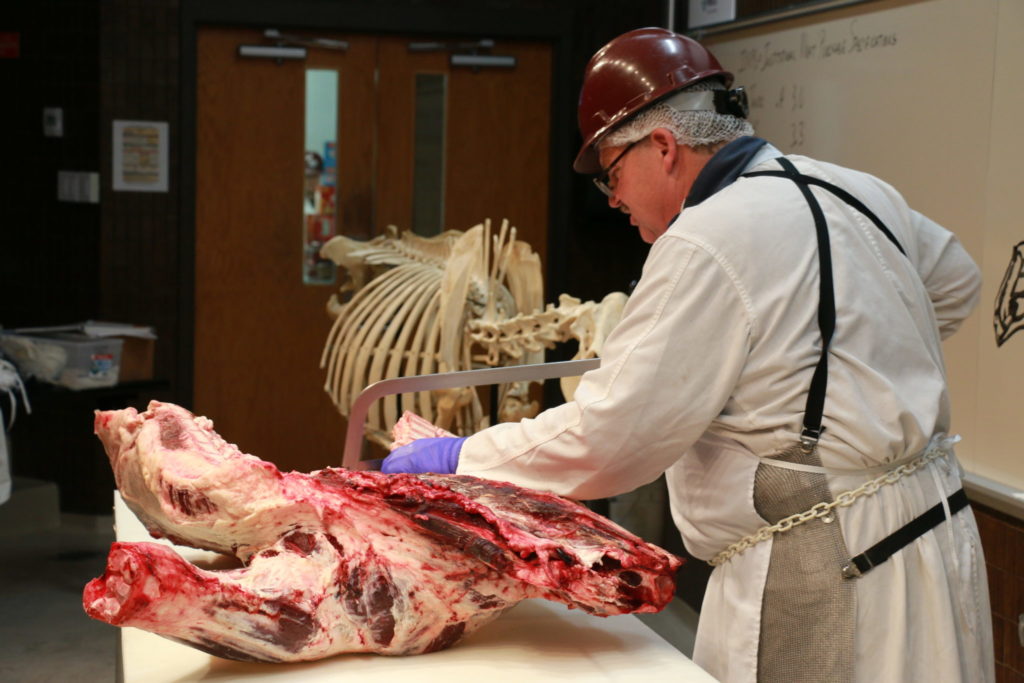
Davey Griffin breaking a beef forequarter
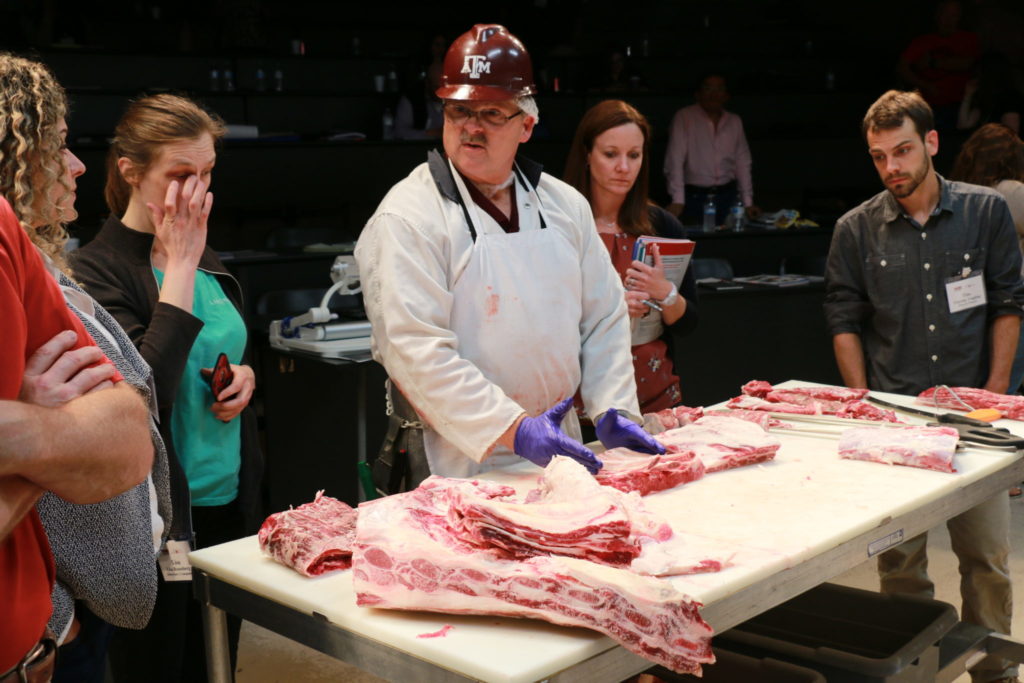
Davey Griffin talking most beef rib cuts
The pork portion of the training was conducted past Jimmy Murray and Clay Eastwood of the National Pork Board with help from Davey Griffin.
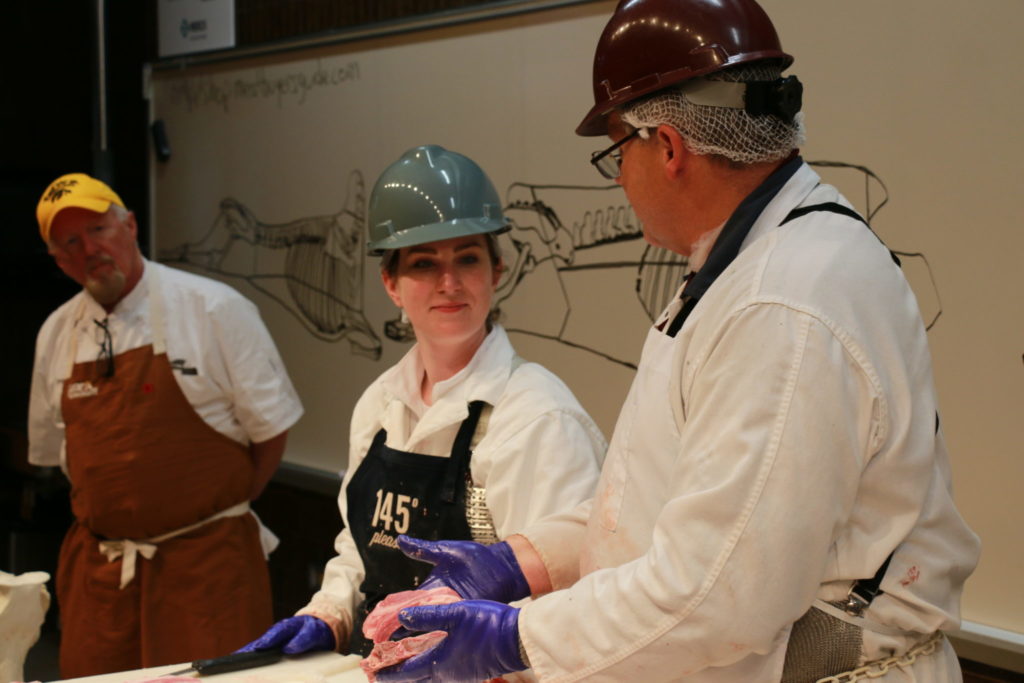
Jim Murray and Clay Eastwood, National Pork Board, and Davey Griffin, cutting pork at the NAMI Middle of the Plate Training
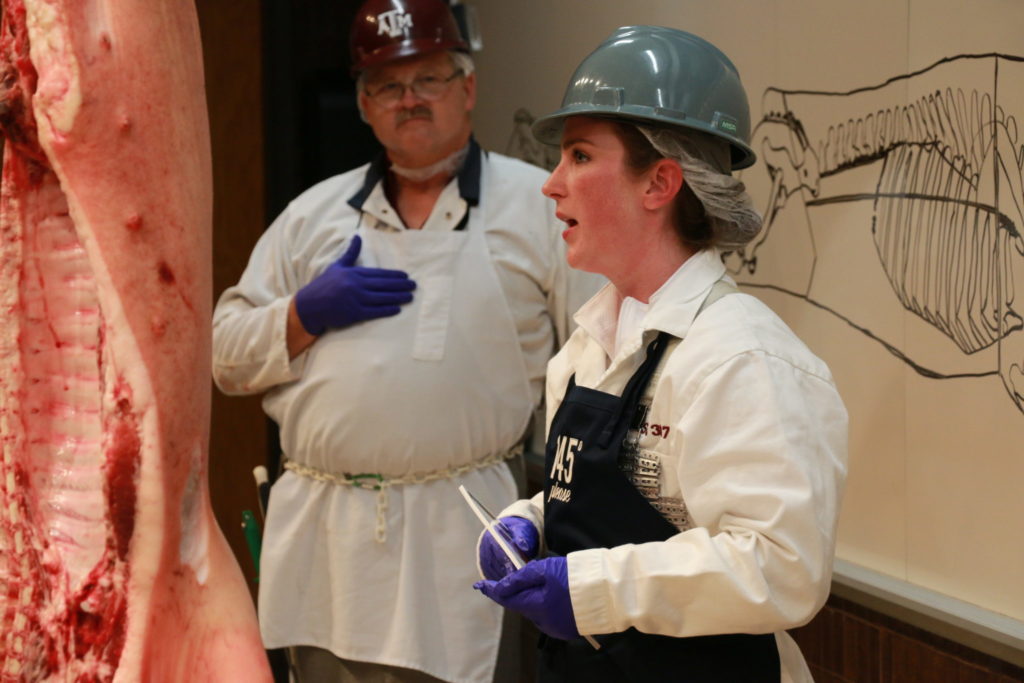
Clay Eastwood, National Pork Board, talking about pork quality at the NAMI Centre of the Plate Preparation

Dirt Eastwood, National Pork Board, cut pork
The poultry portion of the training was conducted by members of the Agronomical Marketing Service of the United States Department of Agriculture. Richard Lawson and Gerald Laird led the discussion on poultry grading, terminology, and common uses of specific poultry products.
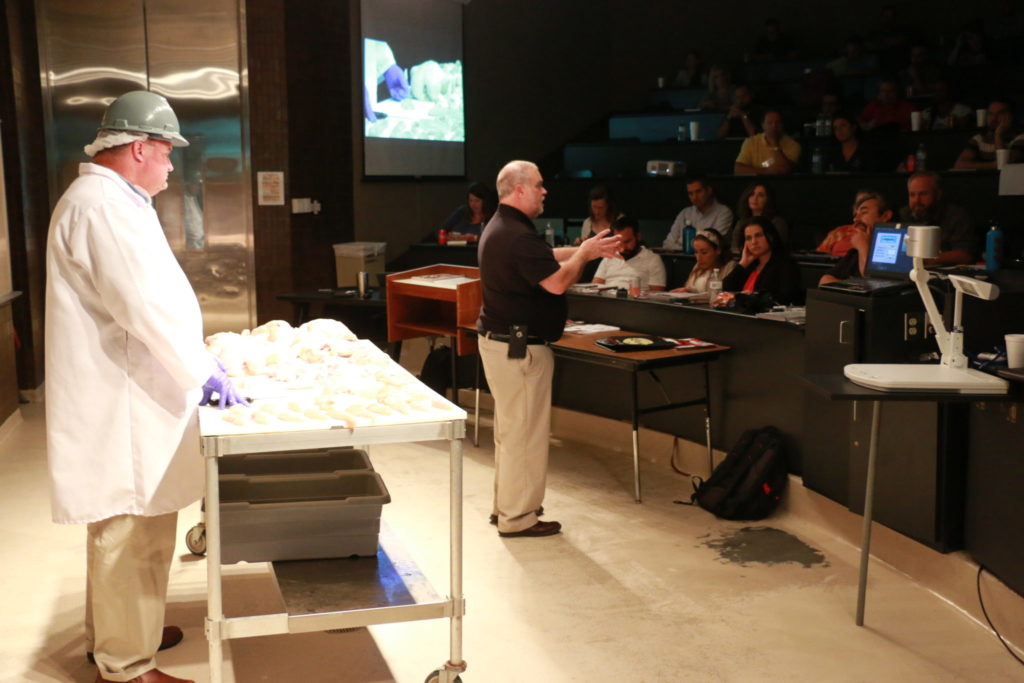
Gerald Laird and Richard Lawson, USDA Agricultural Marketing Service, talking about poultry standards at the NAMI Center of the Plate Training

Gerald Laird and Richard Lawson, USDA Agricultural Marketing Service, discussing poultry grading
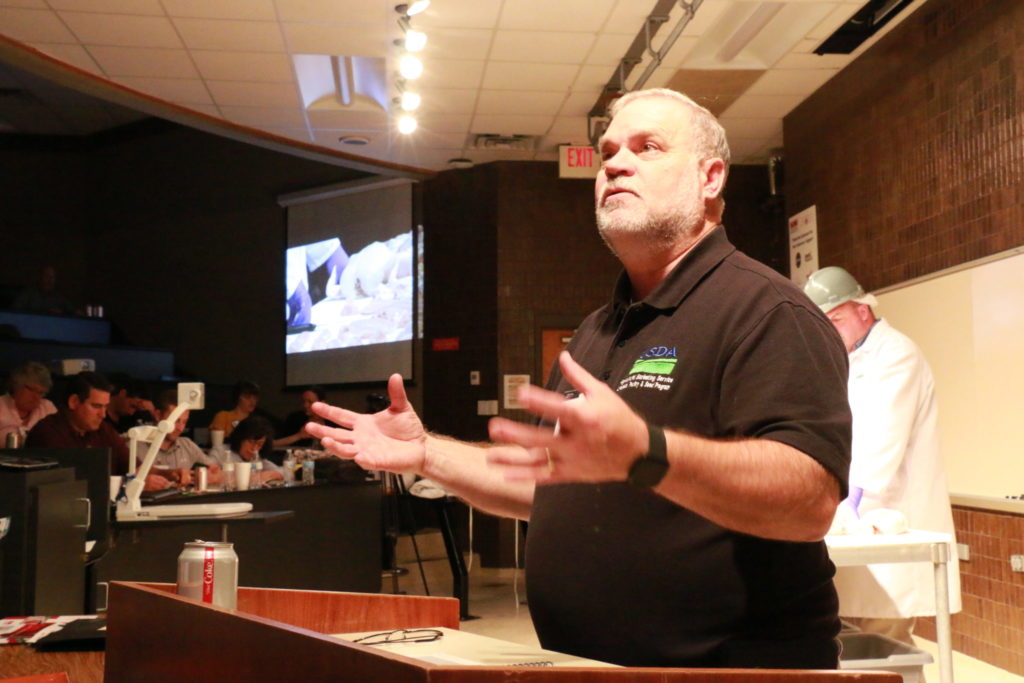
Richard Lawson talking about poultry grading standards

Gerald Laird talking about poultry products
The final portion of the program was a discussion of processed meats led by Chris Kerth. Kerth gave a presentation on processed meat ingredients and labeling, and he showed a variety of locally available processed meat products and the labels and marketing claims made for each.
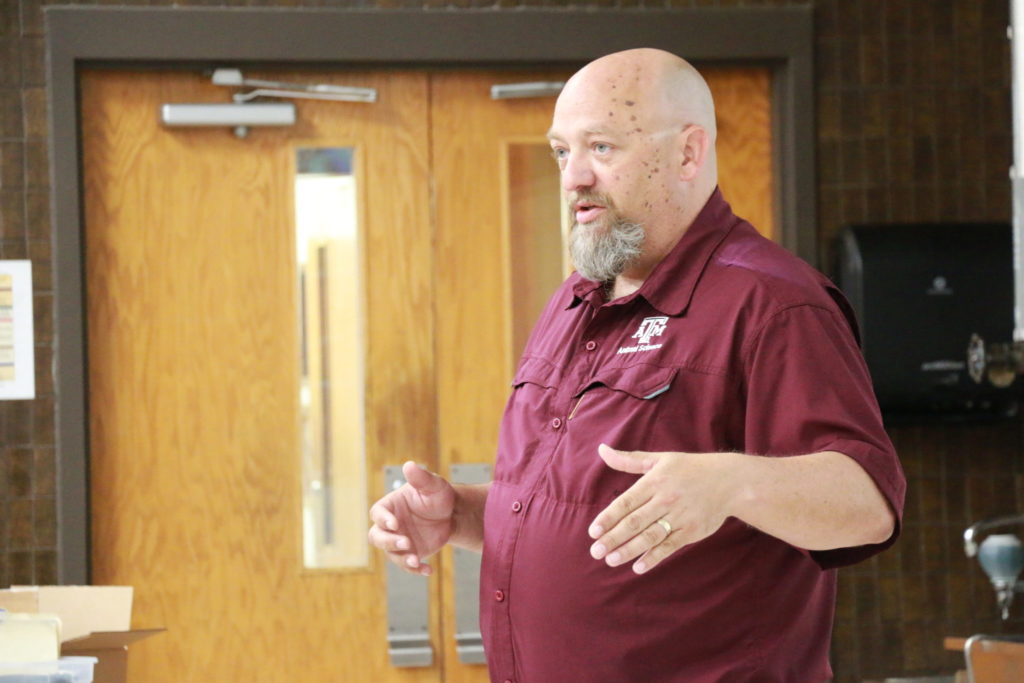
Chris Kerth talking well-nigh meat and poultry labeling at the NAMI Centre of the Plate Preparation
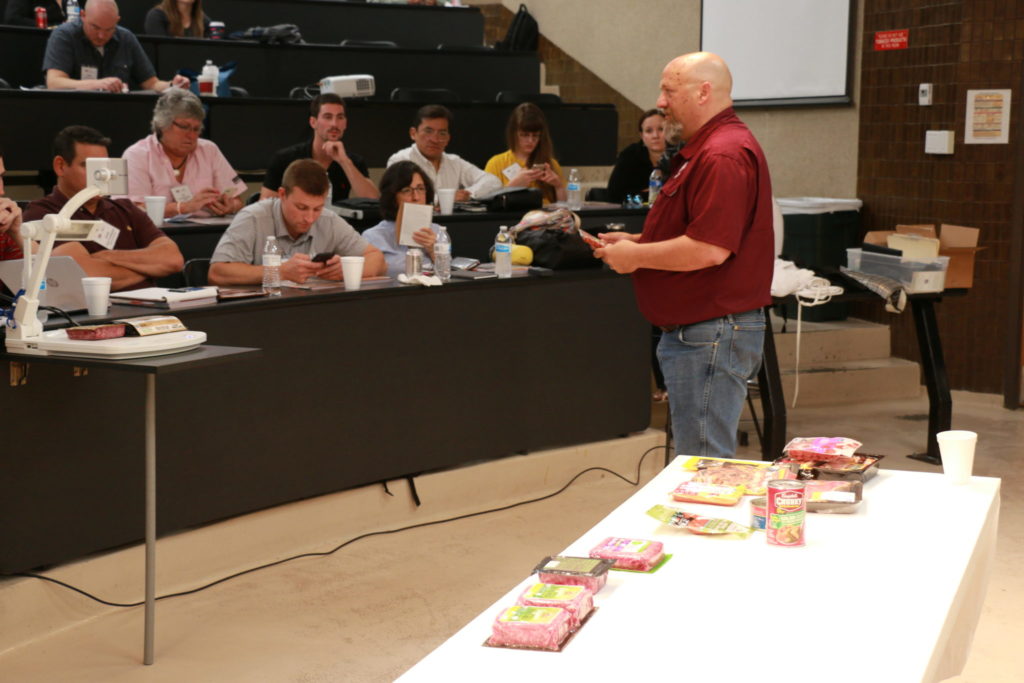
Chris Kerth talking about meat and poultry labeling
Texas A&One thousand University has hosted the Centre of the Plate Preparation since 2005, and we appreciate the opportunity to work with the N American Meat Institute on this programme each year.
Pork 101™ will be held at Texas A&M University, May 21-23, 2019
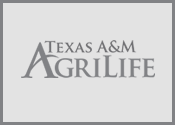

Pork 101™ grading exercise
Register today for the next American Meat Scientific discipline Association's (AMSA) PORK 101™ to be held in May 21-23, 2019 at Texas A&M University in College Station, TX. PORK 101 is hosted past AMSA in cooperation with the National Pork Board and is sponsored past Merck Animal Wellness.
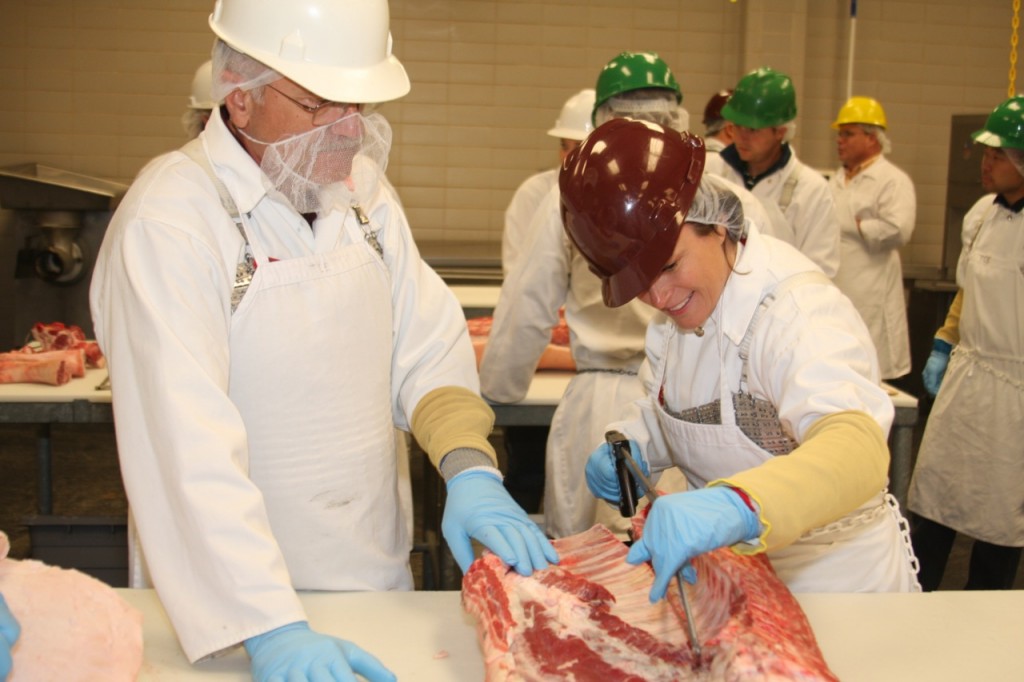
Jeff Savell instructing pork cut
Attendees will experience immediate the swine manufacture from live creature product through finished pork products. The grade concludes with the attendees preparing and sampling products from pork carcasses including pumped loins, bacon, hams, and sausage.
Attendees will have the opportunity to learn about the value differences in swine, pork carcasses, pork primals and candy pork products from meat science kinesthesia and AMSA members at each academy.

Hillary Martinez and Leslie Frenzel leading Pork 101 cutting grouping
PORK 101 is co-sponsored by the American Clan of Meat Processors (AAMP), Due north American Meat Institute (NAMI), Southeastern Meat Clan (SEMA),and the Southwest Meat Association (SMA). Registration for AMSA members and other partnering organizations is $825. Not-member registration is $975. Companies or organizations sending more than one person to the course are eligible for a discount! Infinite is limited for each course so brand sure to annals soon!
For more information or questions regarding PORK 101, please become online or contact Deidrea Mabry dmabry@meatscience.org.
2019 Introductory HACCP Courses and Across Basics Workshops announced
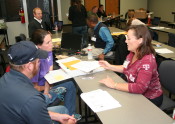
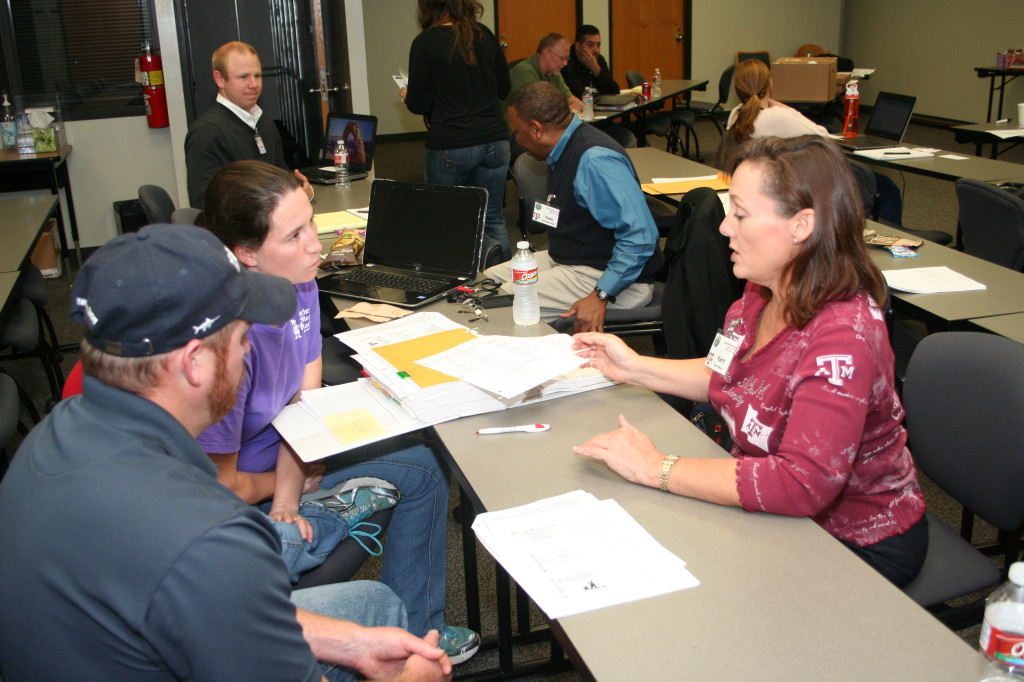
Kerri Gehring assisting participants at Beyond Basics HACCP Programme Workshop
The 2019 dates for Introductory HACCP Course and Beyond Basics: HACCP Program Comeback Workshop have been gear up. All courses are taught in the Kleberg Eye on the campus of Texas A&M University in College Station, Texas by Kerri Gehring and Jeff Savell from the Department of Animal Science.
Introductory HACCP Grade
- March 20-21-2019
- September 4-5, 2019
- December 10-11, 2019
Registration: https://secure.touchnet.com/C21490_ustores/web/product_detail.jsp?PRODUCTID=5280
Across Basics: HACCP Plan Improvement Workshop
- May 7-viii, 2019
- November 6-seven, 2019
Registration: https://secure.touchnet.com/C21490_ustores/web/product_detail.jsp?PRODUCTID=5281
For more information, contact Tiffany Walsingham at 979-862-3643 or twalsingham@tamu.edu.
2019 Creative Sausage making Form at Texas A&M


2019 Creative Sausage Making participants, administration and instructors behind coolers full of the sausage they made.
The sixth annual Creative Sausage Making class was held on January 11-12, 2019 at the Rosenthal Meat Center. CSM is a articulation venture between the Meat Scientific discipline Section of the Department of Animal Science at Texas A&K University and Texas A&M AgriLife Extension Service. Thirty participants, representing charcoal-broil companies, foodservice distributors, retailers, chefs and backyard enthusiasts came to larn sausage product from start to end.

Dr. Osburn led the classroom discussions and presented the science behind sausage manufacturing.
During the program, participants learned the science of basic sausage production, differences in casing types, sausage cooking/smoking and food prophylactic. With the help of Meat Science graduate students and faculty, and additional technical support from Rick Fitzgerald (A.C. Legg) and Greg Mueller (World Casing Corporation), participants formulated their ain batches of both fresh and cured/smoked sausage, stuffed them in natural casings and prepared them for packaging or cooking.

Trent Schwartz helped participants develop their spice blend to brand fresh sausage.

Dr. Osburn kept a watchful eye over the tables as the participants formulated their seasonings.
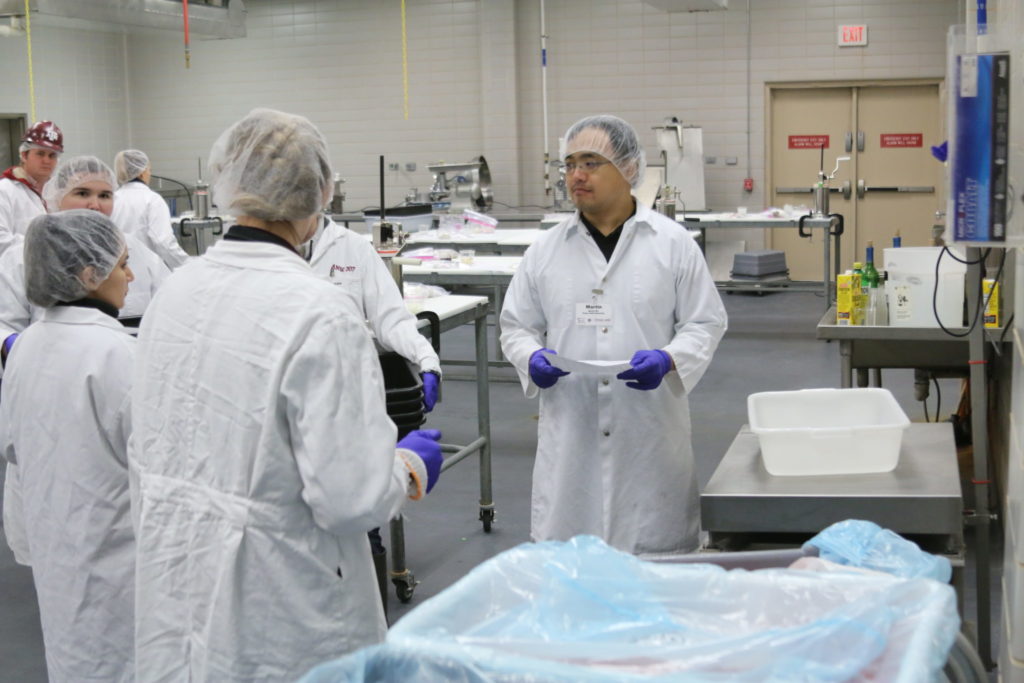
Martin Wu weighed raw materials for his group.
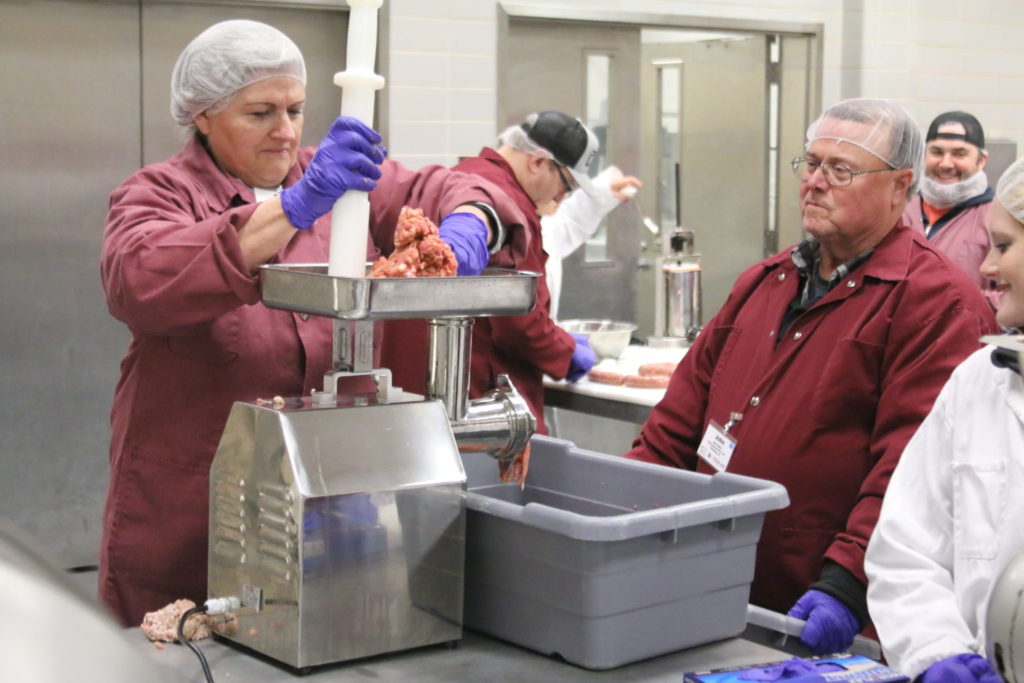
Our new friends from Alabama grinding raw materials.
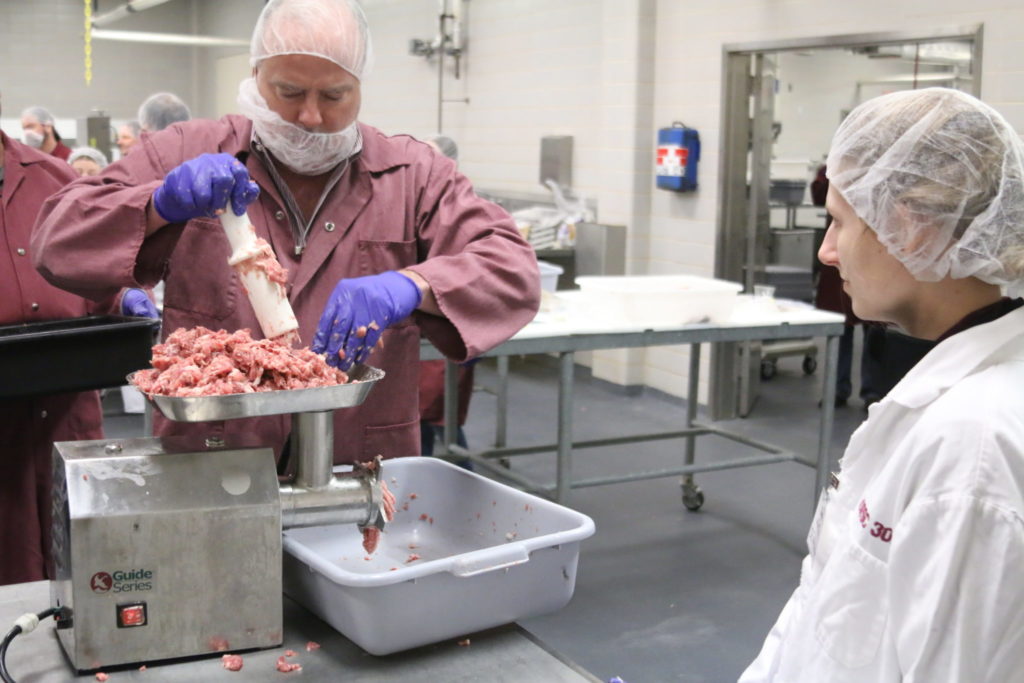
Zena Hicks overseeing raw material grinding.
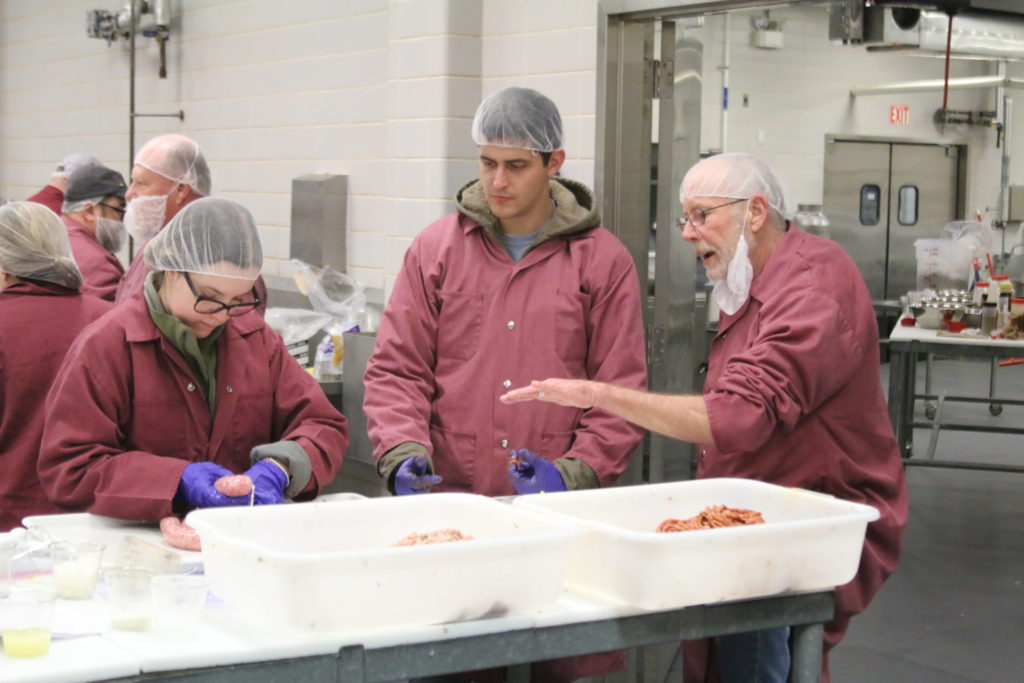
Rick Fitzgerald with A.C. Legg has assisted with educational activity at Creative Sausage Making and has provided spices for use during the camp and for the participants to take domicile with them. He has been providing this service every year since nosotros began hosting the workshop.
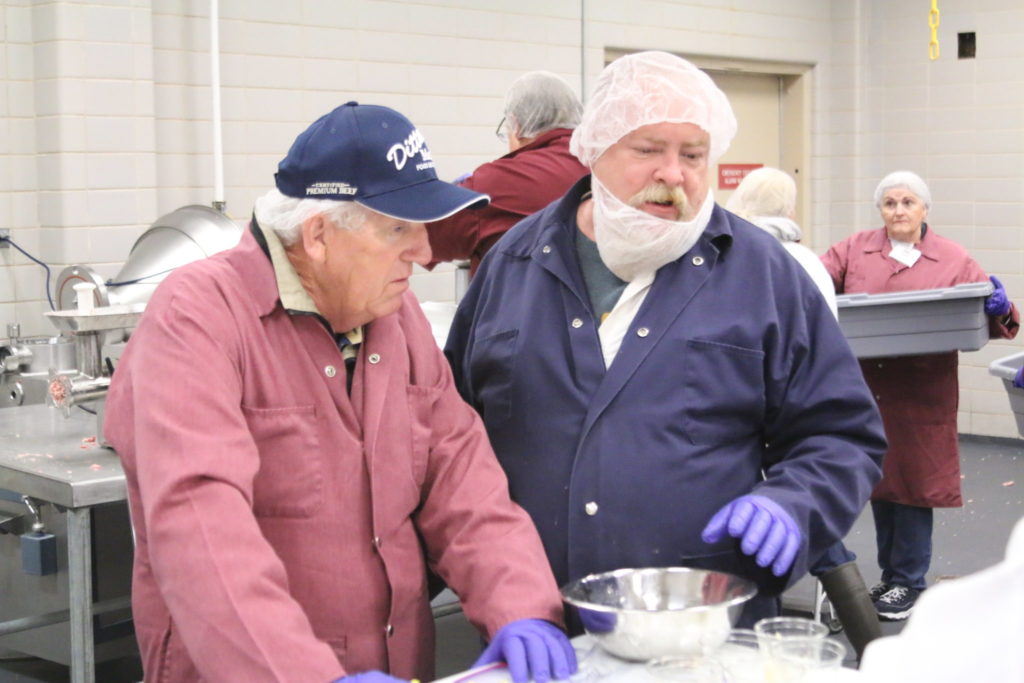
Greg Mueller with Globe Casing Corporation provided the natural casing used at the workshop and was at that place to provide help to participants too as the instructors during the laboratories.

Hanna Laird working with her grouping during Creative Sausage Making.

Kathy Modrow assisting Mackensie Ditta.

Kayley Wall working with her group.
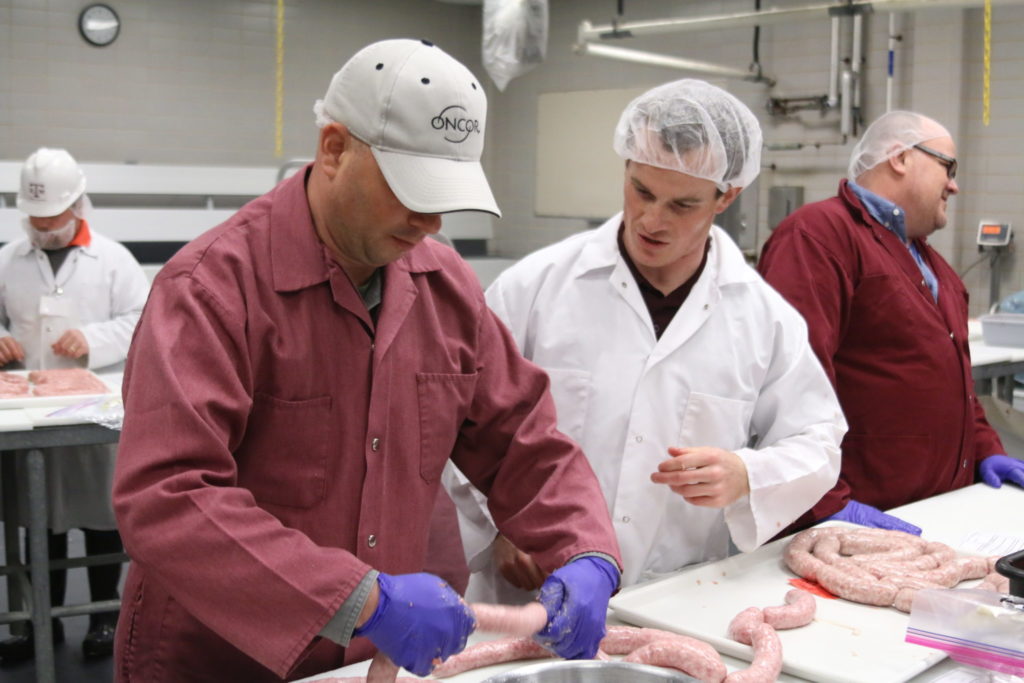
Eric Hamilton overseeing sausage linking.
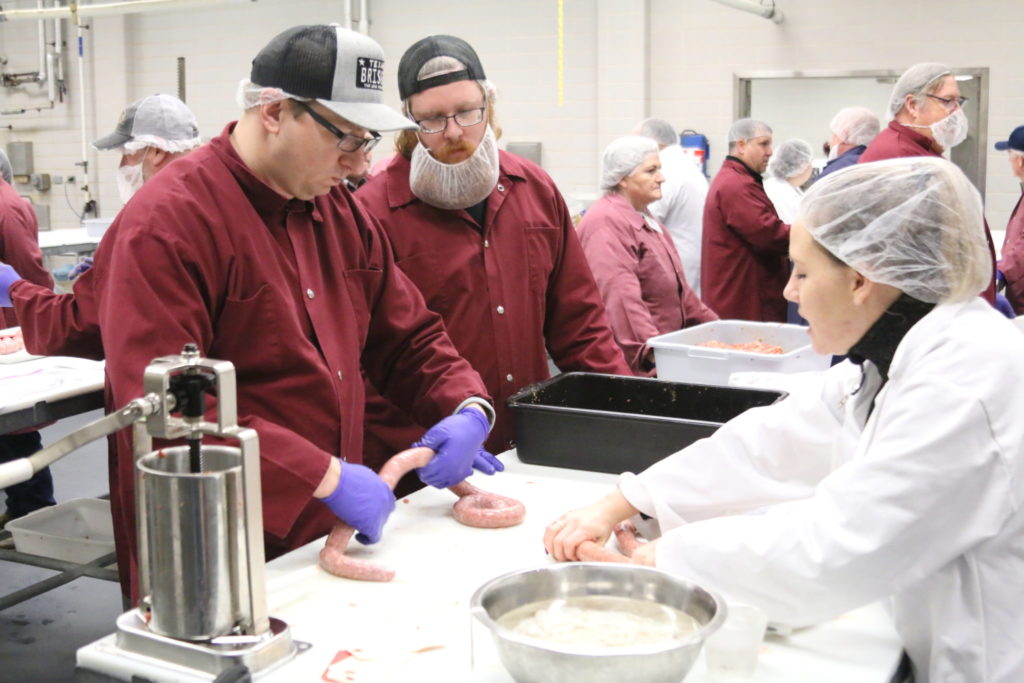
Kayley Wall education sausage linking.

Martin Wu helping to stuff and link.

Sausage linking.
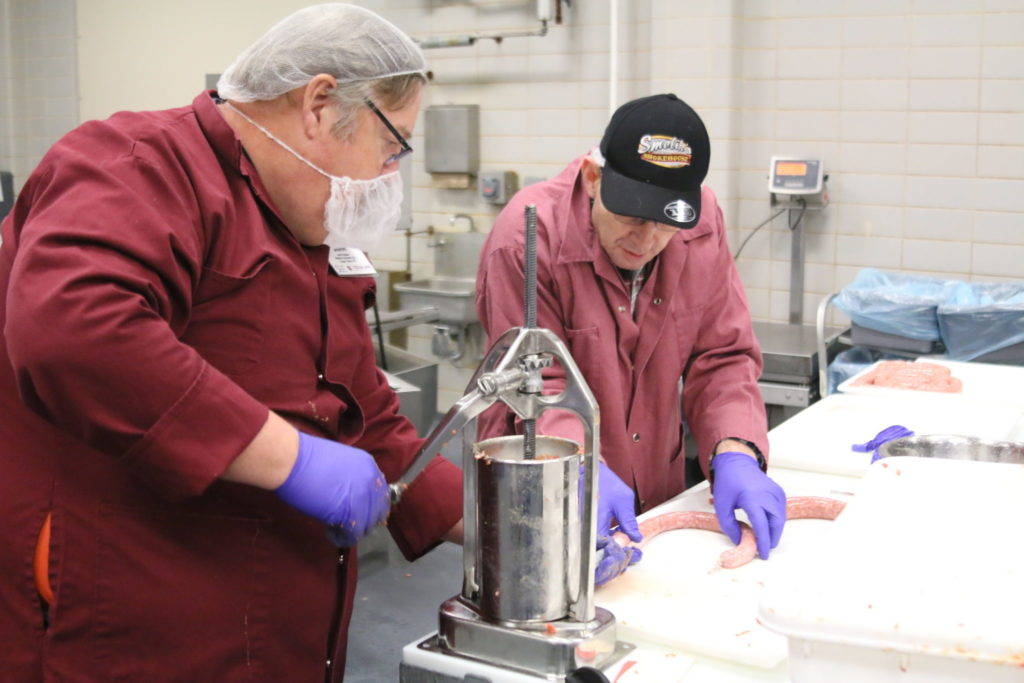
John Baker running the stuffer.
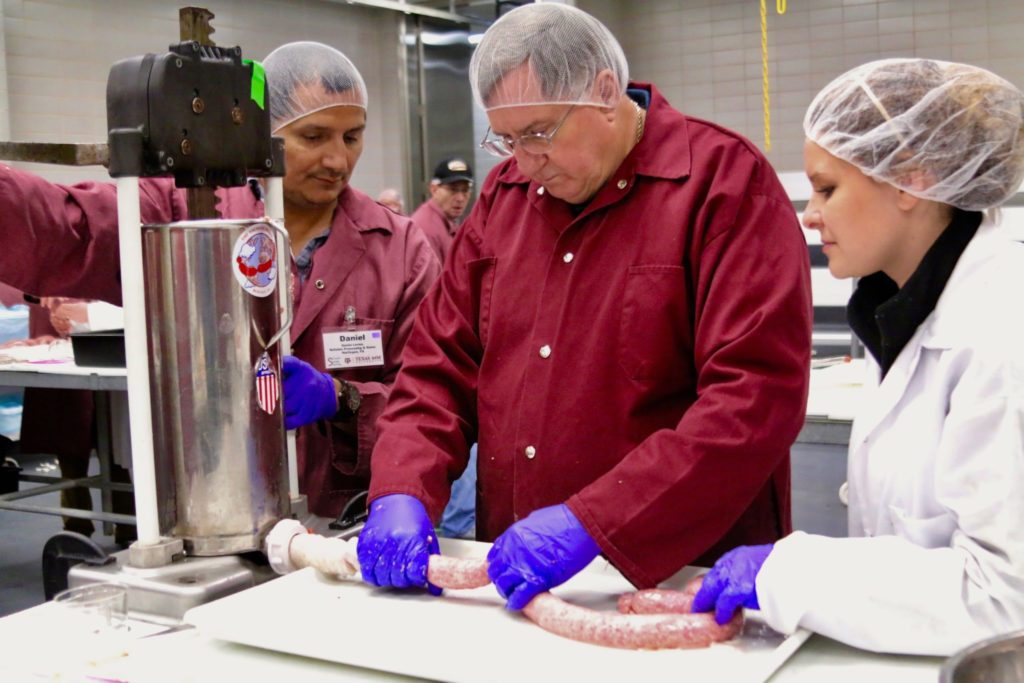
Brogan Horton helping her group stuff.

Dr. Osburn advising
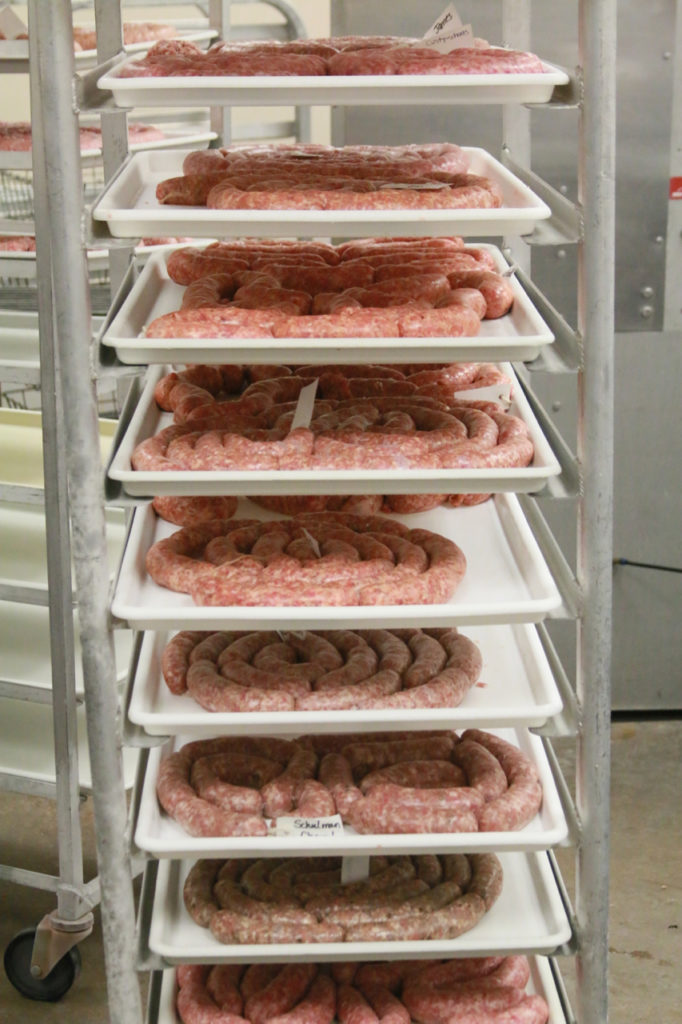
Fresh sausage made by CSM participants.
After the sausage was made, the students assisting with the plan took over. They made certain that each participant's product was properly labeled, and then the fresh sausage was chilled and packaged. The cured/smoked products were hung on sticks, placed on a smokehouse truck and cooked in the smokehouse at the Rosenthal Meat Center. When the products were cooking and chilling, the products were packaged, matched with each person's fresh sausage and placed in individual Texas A&M coolers for distribution.
Starting off 24-hour interval 2, Dr. Matt Taylor and his students led the class through some practical ways to maintain food safety as they have their newly developed sausage making skills back home.
Dr. Wes Osburn and Dr. Davey Griffin led and coordinated the program, respectively. A tremendous group of Meat Science graduate and undergraduate students started preparing for the course earlier in the calendar week by making example batches of each of the sausage products available for participants to brand during the workshop. The products that they made were sampled during the last solar day of the program to requite participants a amend idea of what to expect from their ain products when they got back domicile.
It takes a nifty deal of help and service to brand workshops a success. Students involved in making products, leading groups, cleaning the lab and helping with all the behind-the-scenes activities included Chi-heng (Martin) Wu, Eric Hamilton, Brogan Horton, Hannah Laird, Kathy Modrow, Cassie Peña, Jacob Valenta, Kayley Wall, Morgan Foster, Zena Hicks, Rory James, Trent Schwartz, Holly Sanders, Wilsey Wendler, Ty Robertson and many others. Without their assistance, none of this would be possible.
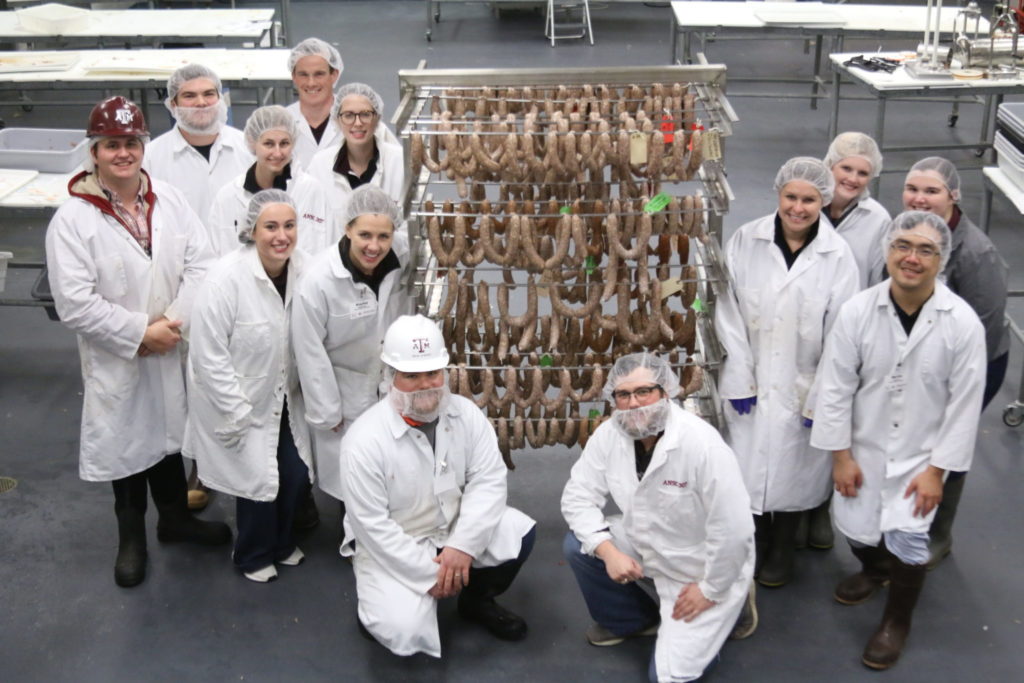
TAMU Crew at CSM
The Creative Sausage making class has been conducted each Jan for the past six years. If y'all are interested in coming to the side by side class, e-mail Dr. Davey Griffin at dgriff@tamu.edu to be put on the advance notice list for adjacent yr's grade.
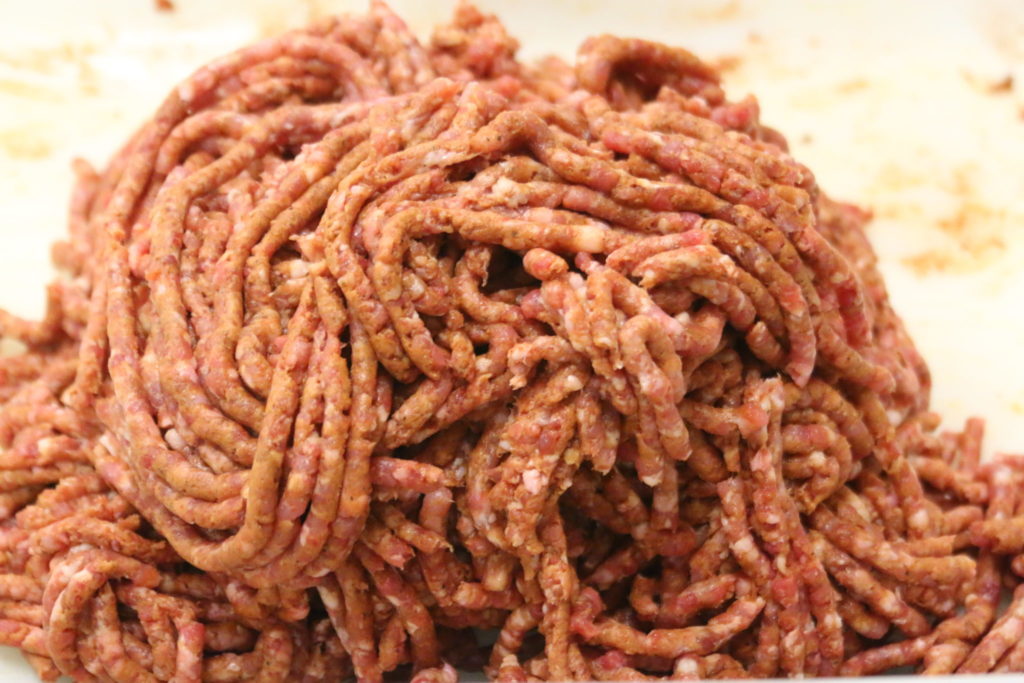
Agreement USDA beef quality grades factsheet bachelor

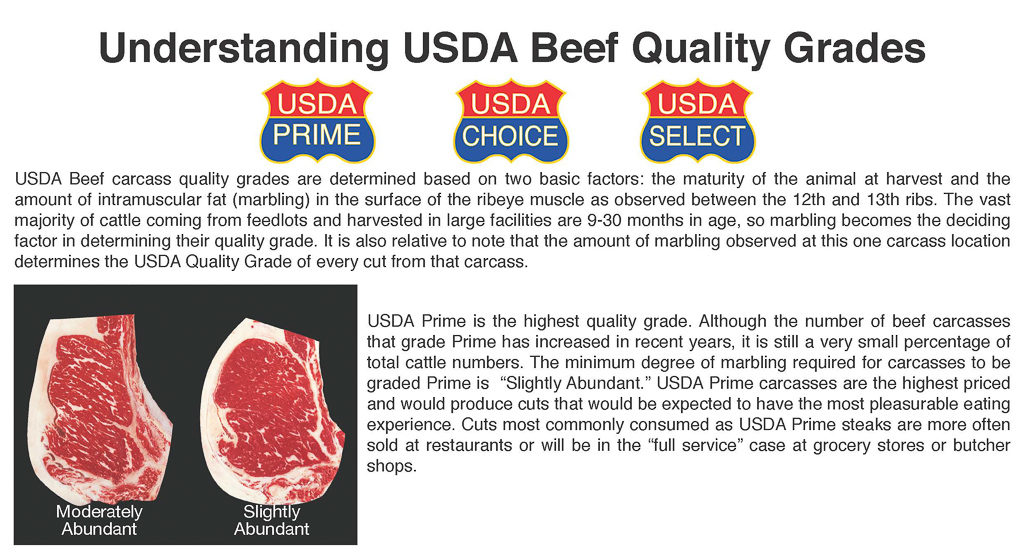 We have prepared a factsheet entitled, Understanding USDA beef quality grades, for those who are interested in learning more near the USDA beef quality grades.
We have prepared a factsheet entitled, Understanding USDA beef quality grades, for those who are interested in learning more near the USDA beef quality grades.
Understanding USDA beef quality grades
Citation for this factsheet:
Griffin, D. B., and J. Due west. Savell. 2018. Understanding USDA beef quality grades. https://meat.tamu.edu/files/2018/x/Understanding-USDA-beefiness-quality-grades.pdf (Accessed October 26, 2018.)
Papers presented at ICoMST 2018 in Melbourne, Commonwealth of australia

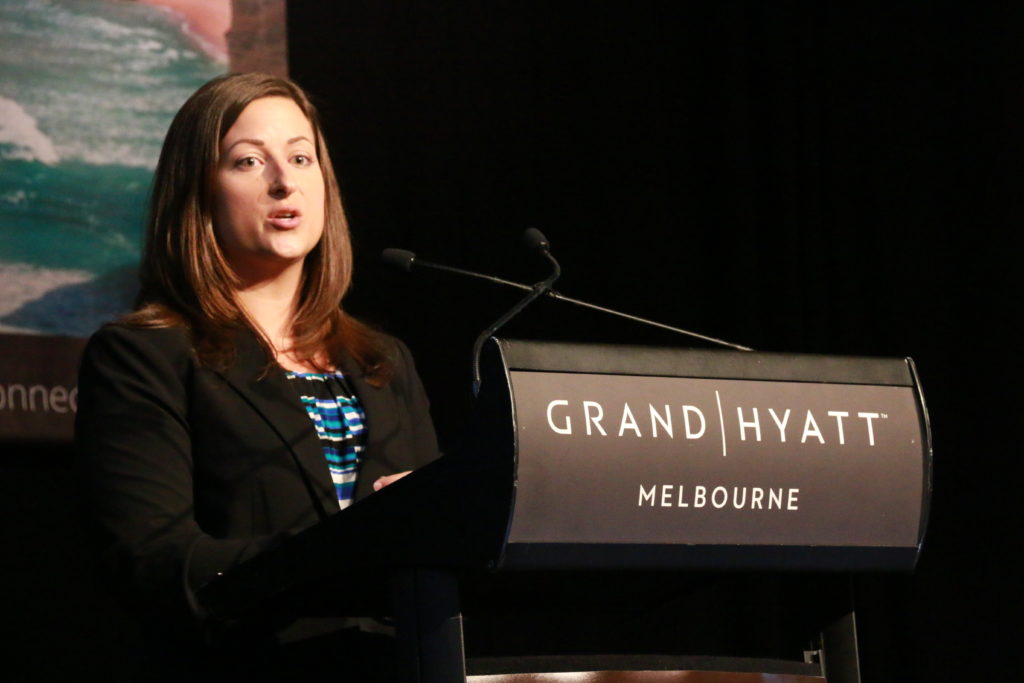
Ashley Arnold presenting her work at the 64th International Congress of Meat Science and Applied science in Melbourne, Australia
Rhonda Miller, Gordon Carstens, Ashley Arnold, Kayley Wall, Chris Kerth, and Jeff Savell of the Department of Animal Scientific discipline at Texas A&M Academy participated in and presented papers at the 64th International Congress of Meat Scientific discipline and Technology (ICoMST), which was held in Melbourne, Australia on August 12-17, 2018. Arnold presented her paper during the oral sessions and the rest of the papers were presented during the poster sessions.
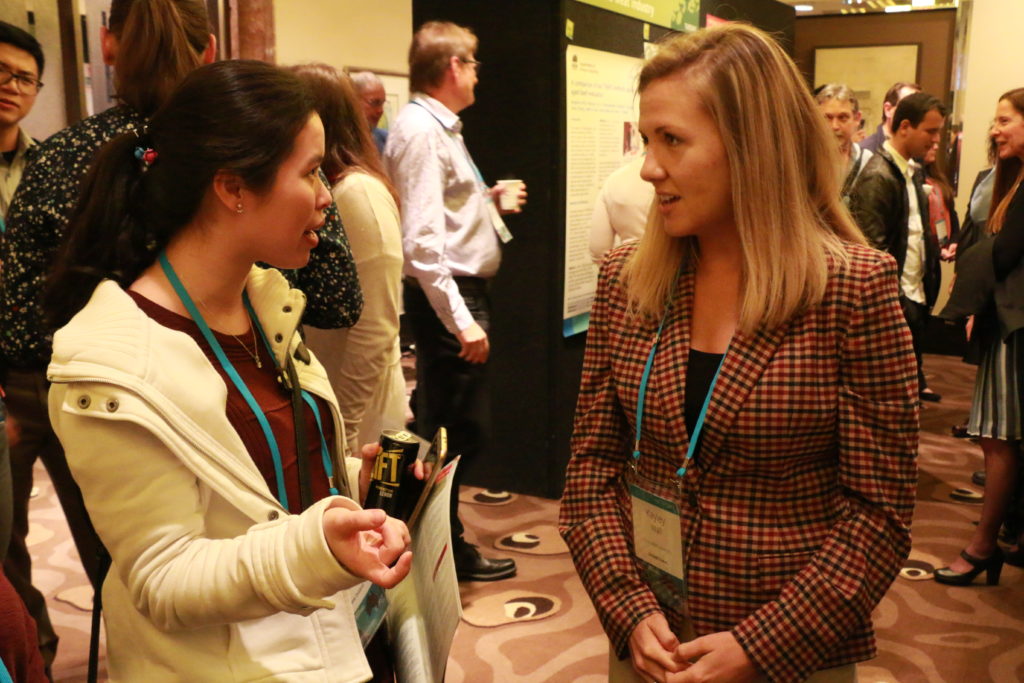
Kayley Wall (correct) discussing the findings of her research at the 64th International Congress of Meat Science and Engineering in Melbourne, Australia
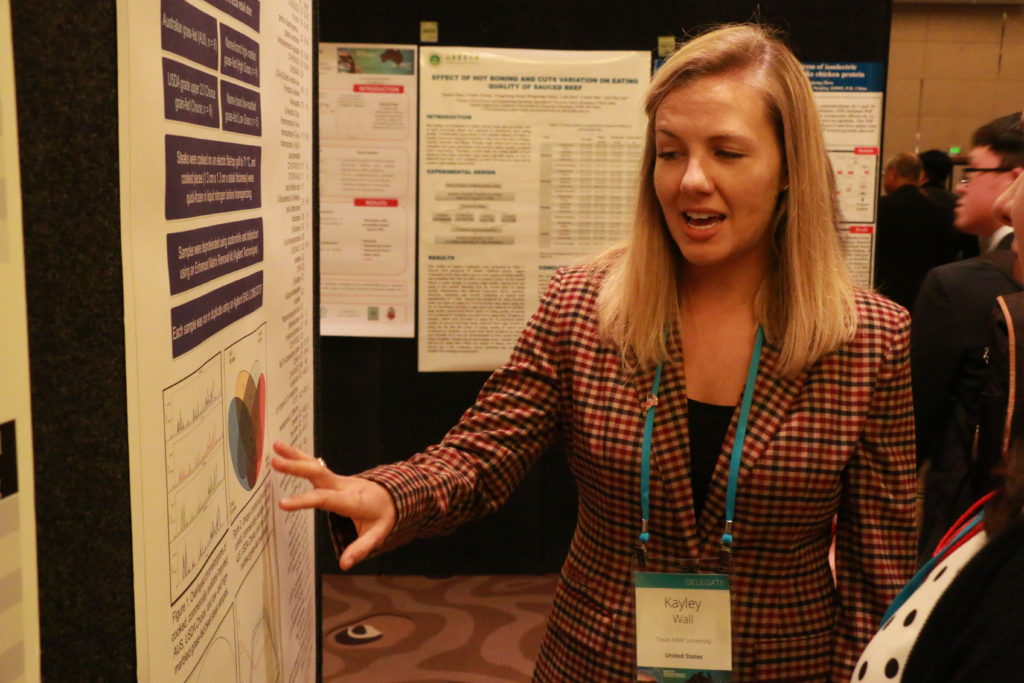
Kayley Wall
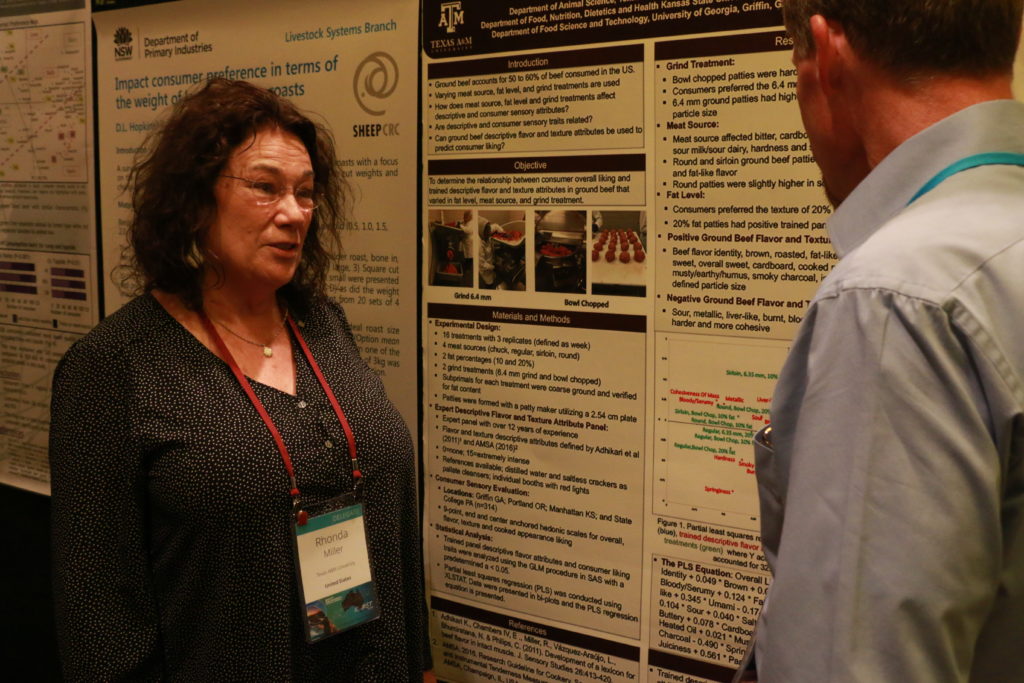
Rhonda Miller discussing her affiche at the 64th International Congress of Meat Science and Technology in Melbourne, Australia

Rhonda Miller
There were approximately 450 attendees from countries around the globe in Australia for the 64th ICoMST meetings. Sessions included provenance and fraud detection; food condom and microbiology; revolution in biometrics and consumer sensory sciences; value adding to meat and offal; next generation technologies to assess carcass and meat quality; glycolytic and proteolytic metabolism across species; smart packaging for quality, safety, and integrity; dietary muscle proteins for phase of life; and process control in the meat manufacture.
Papers
Hither are the five papers presented at the conference:
Arnold, A. N., A. D. Belk, K. J. Nickelson, J. E. Sawyer, D. B. Griffin, T. M. Taylor, J. Westward. Savell, and K. B. Gehring. 2018. Impact of feeding phase, cattle source, and flavor on Salmonella prevalence in bovine lymph nodes. In: Proc. 64th International Congress of Meat Science and Engineering, Melbourne, Commonwealth of australia.
Miller, R. Thou., H. L. Laird, B. A. Beavers, C. R. Kerth, E. Chambers, IV, K. Adhikari, and S. Wang. 2018. Relationship between descriptive flavor and texture attributes and consumer liking of ground beef. In: Proc. 64th International Congress of Meat Science and Technology, Melbourne, Commonwealth of australia. Poster 2F82.
Parsons, I. Fifty., Chiliad. E. Carstens, C. A. Olson, J. R. Johnson, W. C. Kayser, D. S. Unhurt, and R. K. Miller. 2018. Effects of residual feed intake classification on carcass-value traits in finishing beef cattle. In: Proc. 64th International Congress of Meat Science and Technology, Melbourne, Australia. Poster 3K230.
Tindel, Southward. B., A. R. Murray, A. Northward. Arnold, R. Thousand. Miller, D. B. Griffin, K. B. Gehring, and J. W. Savell. 2018. Palatability and tenderness evaluation of beefiness top sirloin steaks from subprimals subjected to blade tenderization, postmortem aging or freezing treatments. In: Proc. 64th International Congress of Meat Science and Technology, Melbourne, Commonwealth of australia. Poster 3K276.
Wall, K., C. R. Kerth, and R. K. Miller. 2018. Metabolomics of cooked grass- or grain-fed beef steaks differing in marbling content and country of origin. In: Proc. 64th International Congress of Meat Science and Applied science, Melbourne, Commonwealth of australia. Poster 2F87.
Students participate in Southwest Meat Clan Annual Convention and Suppliers Showcase

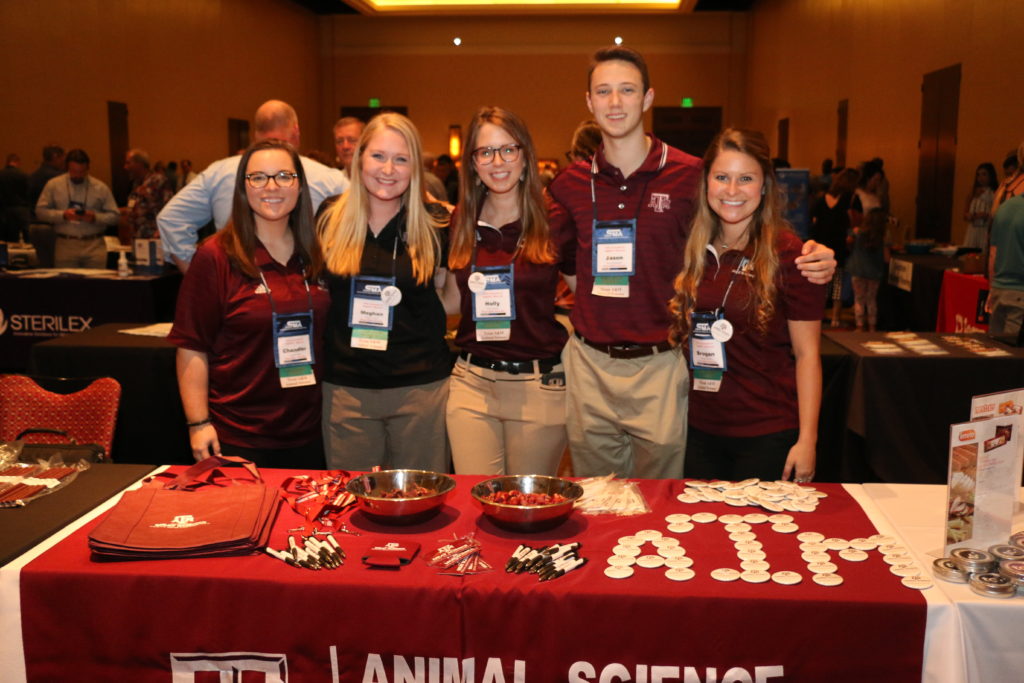
Students Chandler Steele, Meghan Clancy, Holly Sanders, Jason Shamburger, and Brogan Horton at Southwest Meat Association 62nd Annual Convention and Suppliers Showcase
Students from the Department of Animal Science participated in the Southwest Meat Association's 62nd Annual Convention and Suppliers Showcase. Many of the students were there to receive a diversity of scholarships including the Bob Ondrusek Memorial Scholarships, SMA Hall of Fame Scholarships, and SMA Foundation Scholarships. The SMIKids graduate and undergraduate scholarships were presented to Chandler Steele and Bo Garcia, respectively.
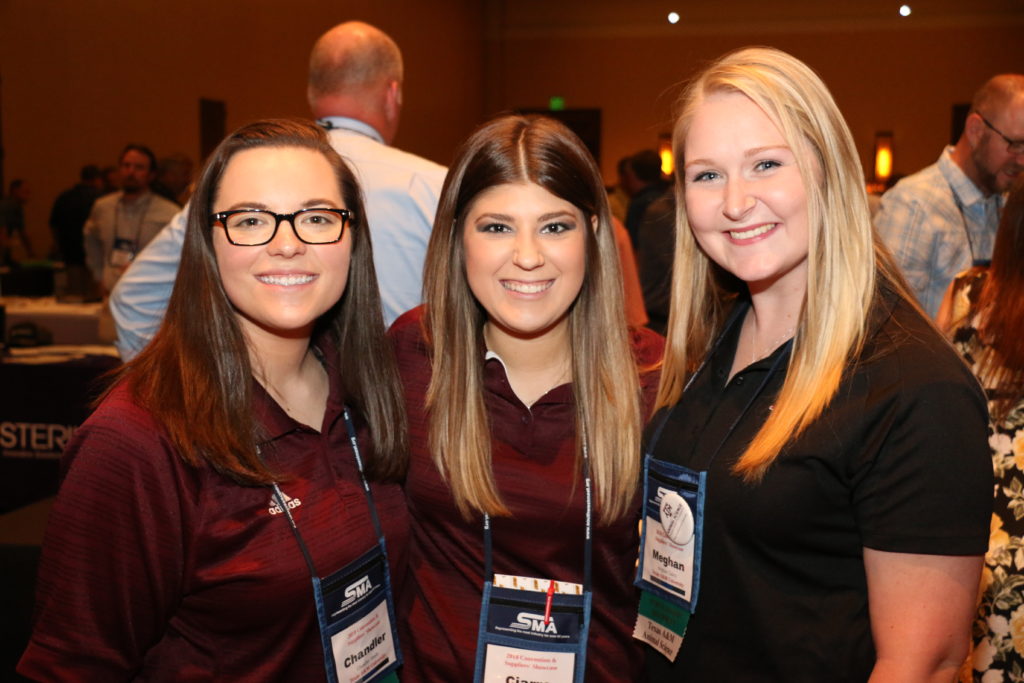
Chandler Steele, Ciarra Gawlik, and Meghan Clancy
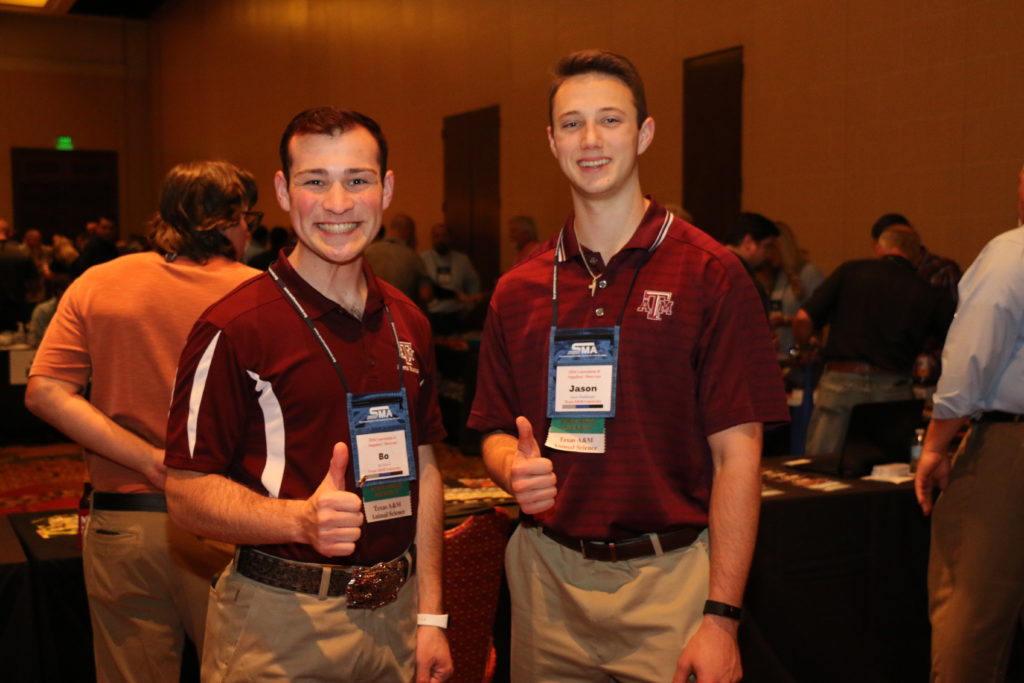
Bo Garcia and Jason Shamburger
In additional to attending the technical and social aspects of the convention, the students participated in the Suppliers Showcase where they visited with the attendees updating them on the diverse programs going on in the department.

Caitlyn Harmon and Sarah Bludau
Ii students, Sarah Bludau and Caitlyn Harmon, served as interns during the convention. Both Sarah and Caitlyn gained valuable experience profitable with many of the activities associated with the convention and suppliers showcase.
Source: https://meat.tamu.edu/news/
0 Response to "North American Meat Processors Associations Names for Cuts of Beef Chart"
Post a Comment